Introduction
In this article I will highlight my MLB Top 50 Pitching Prospects, including a handful of honourable mentions. Each pitcher will have a graphic associated with them that includes information such as biographical data, MiLB statistics, and, most importantly, my scouting grades. These grades are on the traditional 20-80 Grade Scouting Scale and were determined through both statistical and video analysis.
As I learned through this process, the task of writing and compiling a Top Prospects list is not easy. The plethora of research required is time-consuming, and that does not consider the complexity of scouting. I have consumed countless amounts of baseball content in my life, and I would like to thank everyone that inspired and provided me the knowledge to undertake this project.
A special thanks goes out to the following:
MLB for their library of videos in the MLB Film Room. The Film Room provided easy access to videos on each prospect covered in the article.
MLB Pipeline for their prospect coverage.
Tess Taruskin (Fangraphs) for their incredible work on “A Visual Scouting Primer: Pitching” on Fangraphs. All 3 parts of the primer helped me immensely while I was reviewing footage of each pitcher. I also learned a ton from their Prospect Coverage on Fangraphs.
Eric Longenhagen (Fangraphs) for their Prospect Coverage and many articles on Fangraphs.
Aram Leighton (Just Baseball) for their Prospect Coverage on Just Baseball. Aram is a top-notch evaluator, and his work at Just Baseball was a large inspiration for me.
Lance Brozdowski for their indispensable pitching analysis. Lance’s video and posts are chock-full of knowledge that every baseball fan can learn from.
Tom Tango and the MLBAM team, who maintain MiLB and MLB data and keeps it publicly accessible.
Let’s cover some important parts of my scouting process:
A defined a MLB Pitching Prospect as: Any pitcher signed to a MLB Team that has fewer than 50.0 IP in MLB
This differs from my first list which used service time as a stipulation as well. I made this change to simplify my process. This means that pitchers like Zebby Matthews are still considered prospects.
This will also mean that I won’t be comparing a player’s movement up and down the list in this update as the player pool has changed.
I made sure to gather as much publicly available data as possible. Statcast was my best friend during this project, and if a pitcher ever made an appearance in a Statcast Park, I reviewed it. Most commonly, this included MLB, AAA, and FSL games; however, it also includes some College Games, Arizona Fall League, Spring Training, and even the Futures Game. If there was no Statcast Data available for a certain pitcher, I would read scouting reports and posts about players to fill in the blanks, for example, this tweet about Dylan Lesko from Lance Brozdowski.
Reading scouting reports was extremely important. Outlets such as MLB Pipeline, Fangraphs, and Just Baseball helped with the structuring of my analysis. They also helped me understand what to look for in a pitcher, for example, how certain characteristics (such as delivery and size) impact their projections.
Reviewing film via MLB Film Room helped me visualize a pitcher’s delivery and pitches and relate it back to their data.
I used tjStuff+ to help inform my scouting grades, but did not rely on it solely.
I used the 20-80 Scale for my scouting grades with Present Value (PV) and Future Value (FV) being separated for pitch types and command. For Overall FV, I include a “+” in some instances which indicates that a pitcher is approaching the next tier.
Some other notes:
I am not a professional scout, and this is my first time writing an article like this. This whole project was a learning process, and I hope to continue improving in my next update.
As always, I encourage constructive criticism! I would be happy to discuss any prospect on this list or any others that you have questions about.
I am human. Please inform me if I made a mistake!
This list is actually 61 Prospects because I couldn’t stop at just 50.
Now, with that out of the way, we can get to the list. Enjoy!
1) Chase Burns
Burns has the best stuff of any pitcher on this list, and the Reds believed in his tools to select him 2nd overall in the 2024 draft. Burns is the definition of a flamethrower, sitting in the high 90s with his fastball, which exhibits a ton of ride. Due to his delivery and high release point, the pitch approaches the plate at a steeper angle, which may inflate damage against the offering. His breaking balls, a slider and a curveball, boast high velocity and have a good amount of depth. His slider sits in the high 80s and is difficult to pick up from his high slot. His curveball sits in the low 80s with more two-plane movement than his slider. He rounds out his arsenal with an unpolished changeup. His explosive delivery and over-the-top release are high effort which may hinder growth in the command department, but his stuff is simply too good to place him anywhere other than #1.
2) Roki Sasaki
Roki Sasaki made waves in the baseball world this decade with his high-powered fastball and unicorn splitter. He consistently averaged upwards of 100 MPH on his fastball in the NPB with excellent shape. He accelerated his timeline to MLB as signed with the Dodgers this past winter. His state-side debut was marred by similar concerns as his final NPB season. His velocity was down (96-97 MPH) and his fastball shape was decidedly dead-zone. Without its elite velocity, the pitch is simply an average offering which will struggle to generate whiffs. To pile onto the pessimism, Sasaki’s command has looked putrid. His best pitch is his extremely low-spin splitter that exhibits both glove and arm-side movement. He rounds out his arsenal with a decent slider that sits in the low 80s with nearly 1’ of sweep. Overall, Sasaki has the tools to be one of the best pitchers in the world, but injuries and inconsistencies have put a damper on his North American debut.
3) Jackson Jobe
Jobe is the complete package, and he keeps adding onto it. He has stacked 6-pitch mix highlighted by one of the best fastballs in MiLB and supported by improved command. His fastball sits at 96-97 mph with and can reach 20” of iVB. He’s showcased the ability to hit 100+ mph, which transforms his fastball into one of the best in MLB. Jobe tosses a trio breaking balls: a slider, a sweeper with a ton of spin, and a brand-new curveball. His sweeper averages 83 MPH, and he gets a ton of late break with 17” of glove-side movement, although he dialed back on its usage. His slider sits between 89-91 MPH with varying levels of depth. Jobe rounds out his arsenal with a changeup that sits at 85-87 MPH and a new mid 90s sinker that mimics his changeup’s movement. In-zone whiffs, particularly with his fastball, have been an issue for Jobe against higher level competition. His upside is that of an ace and leveraging his elite stuff and solid command should help him reach that level.
4) Andrew Painter
Nominative determinism worked overtime with Painter as he projects to be a top of the rotation starter with bonkers stuff and great command. Painter was on the fast track to Philadelphia as he mowed through MiLB batters in his 1st full professional season while showcasing elite stuff and pin-point command. Unfortunately, Painter has had his Major League debut delayed for 2 years since suffering an elbow injury during 2023 Spring and undergoing Tommy John Surgery later that year. Painter made his return in the Arizona Fall League (AFL), where all signs point towards a return to form. Typically, command is the last thing to settle in following TJS, but Painter seems to have no issue tossing strikes and generating a ton of in-zone whiffs. His fastball is sitting at 97 MPH, matching his 2022 levels, but he hasn’t registered a pitch over 100 MPH yet. He wields 2 different breaking balls: a slider at 86-88 MPH with 7” HB and a curveball at 80-82 MPH with two-plane movement. His changeup is still a work in progress, but thanks to Painter’s command and drastically different velocity bands, the pitch should be effective at inducing whiffs. Tapping back into his fastball dominance is the focal point, and with Painter’s command looking unfazed following his elbow injury, it bodes well for a quick path to Philadelphia and a future top of the rotation projection.
5) Bubba Chandler
Chandler has a prototypical pitcher’s body backed by an electric fastball and increased confidence in his changeup. Chandler was raising red flags earlier in 2024 despite the strong results, as he was up to 70% Fastball usage with his changeup essentially nowhere to be seen. Chandler started diversifying his arsenal and was rewarded with a promotion to AAA, where he continued to dominate. From an initial glance, Chandler seems to be cut from the same cloth as fellow Pirate Jared Jones. Both wield a similar 4-Pitch mix highlighted by a 4-Seam Fastball, which sits at 97 MPH and gets above-average vertical movement from a lower release. While Chandler’s slider may not be a whiff-inducing machine, his changeup has been the most encouraging development this season. The changeup sits 89-91 MPH with over 10” of vertical separation from his 4-Seam, and thanks to its running action, can get some nasty whiffs when located well. His delivery is on the aggressive side, which may limit him from making strides in the command department, but his athleticism should allow him to make the necessary adjustments to limit walks. Chandler projects to be a top of the rotation arm and should be up in Pittsburgh very soon.
6) Zebby Matthews
Zebby Matthews is a big-bodied righty that has always posted elite command metrics throughout his pro-career. He soared through the Twins system in 2024 following a velocity bump and earned himself a well-deserved promotion to the Majors. Unfortunately, he struggled in the early going as his arsenal was hit hard, but he still maintained a strong K-BB%. Early into 2025, Matthews seems to have found another gear, adding +2 MPH across his entire arsenal and topping out at 99.2 MPH. His fastball has an ideal combination of power, ride, and command which pushes it near elite status. His slider and cutter are two excellent secondaries sitting in the high 80s and low 90s respectively. His slider exhibits tight glove side movement while his cutter averages 12” of iVB. He also tosses a two-plane curveball and an above average changeup which should help him tackle LHH. Matthews rapid velocity growth makes him one of the most exciting pitching prospects in baseball and he hasn’t displayed any degradation to his plus command. He has all the tools to be a frontend starter.
7) Jack Leiter
Leiter has had the spotlight on him since he was drafted 2nd overall in the 2021 draft and subsequently debuted in AA during the 2022 season. With a full offseason to work out his issues, Leiter looks the back top prospect self. Leiter’s fastball has a ton of life, sitting 97-99 MPH while averaging 17” iVB from a 5.6’ release and 6.9’ extension. Early on in 2025, Leiter is consistently hitting triple digits with the offering while maintaining a very flat VAA. His slider sits in the upper 80s with tight two-plane action. The newest additions to his arsenal, his sinker and kick changeup, lay the foundation for Leiter to tap into his potential. His sinker sits 96-98 MPH with equal vertical and horizontal movement, making it an effective damage mitigating pitch against RHH. The changeup sits in the low 90s with incredible amount of depth, but he has struggled to command it well. He rounds out his arsenal with his typical curveball which he leans on against LHH. Leiter wields some of the best stuff in baseball and it finally looks like he has the arsenal to tackle any batter. His upside is a #1/2, and he’s already showing that off this season.
8) Chase Dollander
Dollander has one of the most complete fastballs in the minors. He sits 97-98 MPH while averaging 14-16” of iVB from a 5.5 ft release height. He pairs this excellent shape with strong command to create a monster of a pitch, particularly when he locates it high in the zone. He features two breaking balls, a slider/cutter that sits at 88 MPH, and a huge two-plane curveball that sits at 78 MPH. The slider/cutter sits in this upper 80s with moderate sweep and ride has started to become his main breaking ball. He is showing better feel for his changeup with its high 80s velocity and near 0” iVB elevating it to a plus offering. He has a fluid delivery, which sometimes looks effortless. His command will elevate his deep arsenal and should make his fastball a nightmare for batters at any level. I really like Dollander’s foundation, and it makes me optimistic that he will succeed in Coors as the ace of their rotation.
9) Noah Schultz
Schultz is a behemoth on the mound, standing at a towering 6'9” while wielding arguably the best pitch in the minors in his sweeper. Schultz has consistently dominated batters since being drafted in the 1st round of the 2022 draft. He utilizes his towering presence to his advantage as he is able to get a 5.5 ft vertical release point from a lefty sidearm delivery. His arm action has the added benefit of allowing him to get a ton of glove-side movement on his high-spin sweeper. His fastball possesses some strong characteristics, including sitting 95-97 MPH with 16” HB, mirroring his huge sweeper. However, his sinker has struggled with missing bats and allowing a lot of damage. Schultz added in a cutter and changeup to round out his arsenal, but both offerings are not polished. The results through his first 2 MiLB seasons speak for themselves, as he has consistently thrown strikes and tore through the lower minors with elite strikeout rates. His sinker may not become a dominant pitch in the Majors, but its physical characteristics portend well for further development. His prospects as a starter hinge on limiting damage against his fastball and further improving his changeup and cutter, with his sweeper raising his ceiling to lofty heights.
10) Grant Taylor
Taylor was projected to go in the 1st round of the 2023 draft, but an injury-laden 2023 and eventual Tommy John surgery resulted in him slipping to the 2nd round. When healthy, Taylor boasts some very promising tools, including extremely high extension. His over-the-top delivery leads to a steep plane on his high 90s fastball which grades out as a plus offering due to its above-average ride for his 5.7’ release point. He wields a trio of hard breaking balls in his cutter, slider, and curveball. Each of those offerings are intriguing and flash plus, and some time plus-plus characteristics. The most interesting pitch of Taylor's arsenal is his new kick changeup, similar to that of fellow White Sox Davis Martin. The pitch exhibits late break and flashes plus traits, with command limiting its effectiveness. His injury history and violent delivery may restrict him to a bullpen role in the future, but Taylor looks fully healthy, and his stuff is setting off alarm bells and warrants a spot near the top of this list.
11) Quinn Mathews
Matthews was a huge riser last season, and he looks to be off to a similar start this season. His velocity is back to his early 2024 levels as he is sitting 93-96 MPH on his fastball. He generates a good amount of ride from a 5.5’ release height, which has led to plenty of whiffs. He has a great feel for his changeup, and thanks to its late break, it has been extremely effective at shutting down RHH. He wields two breaking balls: a mid-80s slider with moderate sweep and a two-plane curveball. His slider is a very effective put-away offering and grades out well, while the curveball may be limited to an early count pitch to steal strikes. Matthews has also flashed a sinker which should give him an early count weapon against LHH. It will be key for Mathews to retain his improved velocity over the course of a full season and maintain his pitch shapes. He has the frame to be a workhorse and the command to be a strong mid-rotation arm.
12) Thomas White
Thomas White wields a solid 5-pitch mix highlighted by a mid-90s fastball and a big, sweeping curveball. His fastball is a plus pitch thanks to the ride he can generate on the offering. He can hit up to 99 MPH and averages 17” iVB. His slurve is his lone breaking ball with over a foot of glove-side movement and a fair bit of drop. It is effective at generating whiffs, and he isn’t afraid to throw against opposite-handed hitters. Over the winter, he added a gyro slider and sinker to his arsenal which both grade out as average offerings. He rounds out his arsenal with an average-to-plus changeup, which sits at 85-87 MPH. His control metrics have been encouraging, including a drop in BB% following his promotion to Hi-A. His longer arm action tends to get in the way of his consistency, which may limit his command as he develops. White’s results were excellent for a teenager, and his frame and tools bode well for him as a future mid-rotation starter.
13) Richard Fitts
Richard Fitts is a command-over stuff pitcher who saw an increase in his stuff following his trade to Boston. Fitts tosses a cut-ride fastball, which flashes plus thanks to its mid 90s velocity and 15” iVB. It hasn’t had the greatest results, but he utilizes it all counts to register called strikes. His slider has tight glove-side movement. He has a great feel for the offering and uses it evenly against LHH and RHH. His sweeper is an extension of his slider with more glove-side movement, and he mostly uses it as ahead in counts against RHH. His primary off-speed pitch changed throughout this career with its current form being a kick changeup. The newer changeup flashes plus, but his feel for the pitch is less refined. Over the winter, Fitts added in a sinker and a curveball to provide him more options early in counts. Fitts’ smooth and repeatable delivery has helped him maintain high Strike% throughout his pro career and makes me confident that he could be an effective starter for the Red Sox in 2025. His arsenal grades out well, and unlocking his kick changeup could bump his ceiling to #2/3 starter.
14) AJ Smith-Shawver
Smith-Shawver made waves in 2023, storming through 3 MiLB levels before making his debut mid-season at just 20 years old. His MLB stint was short-lived, only throwing 25.1 innings. The Braves opted to let him develop in AAA during 2024, where he pitched 87.0 IP with mixed results. Smith-Shawver threw more strikes in 2024, raising his Strike% from 60.3% to 63.3%. In the process, he started throwing his splitter a lot more often. While it got hit hard, it was an effective put-away pitch, posting a 44.6 Whiff%. He does an effective job killing spin on the offering and generating vertical and horizontal separation from his fastball. His fastball lives in the mid 90s with a above average ride from a 5.8’ release point. The rest of his arsenal features 3 breaking balls. He opts for his slider against RHH, which has cutter-like movement and is his most effective option at inducing weak contact. His two-plane curveball is his breaking ball of choice against LHH, acting in a similar fashion to his slider in terms of damage mitigation. His sweeper is a new addition to his arsenal, boasting more drop than a typical sweeper. Smith-Shawver is only 22, which is crazy for a pitcher with a full season’s worth of innings at AAA. He is very athletic, which indicates that he has the capability to make the necessary changes to unlock his ceiling. While the results weren’t great in 2024, he ticked a lot of boxes, which indicate that he is on the right track.
15) Jarlin Susana
Susana was one of the pieces acquired in the trade that sent Juan Soto from Washington to San Diego. Susana has always had very raw stuff, flashing elite velocity as a teenager without a lick of command. In 2024, Susana flipped that script, posting improved Strike% and BB% after his promotion to Hi-A. His ability to limit home runs is exceptional, allowing just 2 across 103.2 IP in 2024. Susana wields two fastballs, a 4-Seam and a sinker, which average 100 MPH and 99 MPH, respectively. He averages 12” iVB on his 4-Seam, which is slightly below average for his ~5.8’ release, but that hardly matters when he can reach 103 MPH. One downside to his 4-Seam is its steeper approach, which limits the offering’s swing and miss potential. His sinker gets more arm-side run with ~14” of arm-side movement. Susana’s secondary of choice is his slider, which features more 2-plane movement than a typical 88-90 MPH slider. Thanks to its downward movement, he is able to miss under bats often and use the pitch to induce weak contact. His changeup looks to be developing well as a whiff-induing offering, but he has struggled to generate strikes with it. Susana has the stuff of an elite closer, and the strides he made in the command department this season have buoyed his floor and elevated him into the upper echelon of pitching prospects.
16) Brandon Sproat
Sproat took Hi-A and AA by storm last season, exhibiting top-end velocity and a wide array of secondaries. Sproat altered his slot to be more ¾ which has translated his pitches to be more North-South, particularly his fastball. This change has also added depth to his trio of breaking balls. His 4-Seam Fastball sits 94-96 and has yet to reach triple digit. Its shape isn’t ideal, especially for his slot, as it demonstrated dead-zone-like movement. Without his typically high-end velocity, the offering’s grade degrades to an average offering. Sproat wields 3 breaking balls: a cutter, slider/sweeper, and a curveball. Each offering has its own distinct movement profile at varying velocity bands. His changeup is the pitch to watch as Sproat readies up for his MLB debut. It sits at 88-90 MPH with 15” of arm-side movement and reaching over a foot of vertical separation from his fastball. It is currently a plus offering and has the potential to be one of the best changeups in baseball. Maintaining his improved strike throwing ability this season will go a long way as he projects to be a mid-rotation starter.
17) Cade Horton
Horton is back after an back injury delayed his MLB debut and he looks better than ever. His fastball has cut-ride shape and sits in the mid-90s, which is closer to his 2023 levels. We have seen the Cubs be effective with these types of fastballs, which focus more on contact suppression, employing it with pitchers like Steele and Assad. With its rebounding velocity, it grades out much better than last season. His secondary of choice is a mid 80s sweeping slider that gets nearly a foot of glove-side movement. His curveball sits 83-85 MPH with moderate two-plane movement. His last pitch is a changeup, which gets over a foot of horizontal separation from his fastball. It flashes plus, but it remains inconsistent as he leaves too many well below the zone. Horton started throwing more strikes later into his AAA stint but was never able to replicate his increased velocity from 2023. 2025 will be key for Horton as he refines his arsenal and builds up to a starter’s workload. His secondaries give him a solid floor as a mid-rotation arm. With his velocity looking back to usual, he has the potential for a very solid 4-pitch mix.
18) Hagen Smith
Hagen Smith was selected 5th overall by Chicago as the 2nd pitcher off the board in the 2024 draft. His fastball gets solid movement from a lefty slot at a 5.7’ release height, averaging 15” iVB and 8” HB. Its sheer amount of break makes it a whiff-generating machine, which he elevates with his tendency to locate it up and arm-side. He also throws a slider, which has tight two-plane movement and sits in the low-80s. It’s combination of sweep and drop makes it both a fantastic whiff pitch and leads to many groundballs. He rounds out his arsenal with a high 80s changeup, which has shown flashes of promise. It is heavily underutilized and will be key in Smith’s path as an MLB starter. Smith is a deceptive lefty whose fastball/slider combo makes me optimistic that he can be a mid rotation starter in the future.
19) Ryan Sloan
Ryan Sloan was selected in the 2nd round by the Mariners in the 2024 draft and has quickly impressed scouts with his combination of size, stuff, and command at just 19 years old. His fastball sits in the mid 90s with ~13” iVB from a 5.4’ vertical release. His slider is a nasty offering, reaching upwards of 20” of sweep while sitting in the mid 80s. It is easily a plus pitch and has the potential to be an elite weapon. His changeup may be the best in the Mariners system thanks to its late fading action. Sloan has the ideal frame for a pitcher which pairs well with his smooth and repeatable delivery. He has a massive up arrow on him and room with plenty of room to fill out. His upside is a frontend starter, and all signs point to him rapidly approaching top pitching prospect status.
20) Rhett Lowder
Lowder enjoyed his cup of coffee at MLB this season, with a very productive 30.2 IP. Lowder won’t knock the socks off batters, but he has a reliable 4-pitch mix and elevates it with above-average command. He throws two distinct fastballs: a 4-Seam and Sinker, which he trades off usage depending on the batter’s handedness. He leans on his 4-Seam against LHH, painting the offering on the outer third. It sits at 93-95 MPH with 15” iVB from an average 5.7’ release. His sinker is his go-to option against RHH early and behind, where he attacks the inner-half of the zone. His slider is his best offering, sitting in the mid-80s with tight movement. His tendency to locate the pitch in ideal spots elevates the pitch to plus status. He rounds out his arsenal with a late-breaking changeup, which he commands well against either handedness. Lowder has a great feel for his 4-pitch mix and solid command. His fastball effectiveness will likely dictate his upside, and he has one of the safest floors as a back-end rotation option of any pitching prospect.
21) Alejandro Rosario
Rosario underwent Tommy John Surgery prior to the 2025 season and will not return until at least 2026 which dropped him out of the Top 10. Rosario was K-BB% King in MiLB during 2024 thanks to his ability to throw strikes. Rosario wields a 3-pitch mix consisting of a sinker, slider, and splitter. He has a good feel for each of the offerings and ran an excellent 68.2 Strike% across A and Hi-A. His sinker won’t miss many bats due to its shape, but it sits at 96-98 MPH and lives in the zone. His slider has two-plane movement at 83-84 MPH. His splitter sits at 88-92 MPH with a ton of arm-side movement and over a foot of vertical separation from his fastball. Rosario doesn’t have a deep arsenal, but each of his pitches is easily average-to-plus, and that is without considering his knack for throwing strikes. He has the foundation to be a mid-rotation starter, and the improvements to his command are very encouraging.
22) Will Warren
Warren had a forgettable MLB debut, posting a putrid 10.32 ERA across 22.2 IP, but that shouldn’t put a damper on the Yankees top pitching prospect. His E-W arsenal includes one of the best sliders (sweepers) in MiLB and a changeup that returned excellent results this season. He throws two distinct fastballs, a 4-Seam and sinker, which both grade out around average. His 4-Seam lives in the top of the zone and has been effective at getting batters to chase. Unfortunately, it sometimes leaks into the heart of the zone, where LHH crush the pitch. His sinker complements his sweeper well, each getting 16” of horizontal break in opposite directions. Warren has historically struggled against LHH, and it was the same story in 2024 season. To combat this, he reworked his changeup to make it have a more distinct movement profile to his sinker. The changeup may be the key to developing into a mid-rotation start. He also reintroduced his curveball this season. One change that is perplexing was Warren’s removal of his cutter. The offering was decent, but helped bridge his arsenal together given his extreme E-W profile. Without it, I expect his sweeper to struggle to generate whiffs. Warren has a solid 5-pitch mix and average command. It’s a great foundation, and his improved changeup should help his prospects as a starter.
23) Kumar Rocker
Rocker rocked the boat in 2024, launching his way through the minors to an eventual MLB debut on the heels of his devastating slider and seemingly improved command. Rocker made his return to pro baseball following his 2023 Tommy John surgery, and he looked stellar. Rocker’s calling card is his deathball-like slider, which simply drops below bats as hitters swing right over it. He wields two fastballs, a 4-Seam and a sinker. Both offerings sit at 96-98 MLB, which is further supported by his elite 7-foot extension. The 4-Seam shape is decidedly dead zone, which may be enough to offset the benefits of its elite velocity. His sinker has a more ideal shape, reaching up to 17” of run. The sinker seems to be the more polished offering with characteristics that should allow it to limit damage. His delivery is noticeably smoother, which is encouraging as his improved strike rate may not be a mirage. The last piece of the puzzle is getting a better feel for his changeup, which he shied away from in his short MLB stint. I find myself bearish on Rocker given his underwhelming fastball shape and poor feel for his changeup. Without its elite velocity, Rocker’s upside is limited to a mid-to-backend rotation starter that needs to lean on one elite offering.
24) Jacob Misiorowski
Misiorowski stands at a towering 6’7” and has the firepower to be a dominant force in the Majors but is hampered by worrying BB% and inconsistent command. His fastball has a near-ideal combination of velocity and ride from a lower slot. He can consistently hit 100 MPH and has a near 7.5’ extension, which helps him get a 5.3’ release height. It is an elite at generating whiffs. His primary breaking ball is a 2-plane curveball that sits in the mid-80s and tunnels well with his fastball. It is his primary put-away pitch and an absolute nightmare for batters when he can hit his spots. He throws a slider/cutter, which sits at 91-95 MPH. The harder variations get minimal horizontal action, with the softer sliders getting ~6” of sweep. He has a changeup but seldomly throws it, which makes it tricky in projecting its value. Misiorowski’s range of outcomes vary greatly, with his floor being one of the best bullpen pieces in MLB and his ceiling being a 1/2 starter. His high-powered arsenal is a function of his explosive delivery, which makes me cautious that he will make meaningful improvements to his command. Nevertheless, his upside warrants a high ranking, and his floor is still a very good outcome.
25) George Klassen
Klassen is a prime example of a team trusting a pitcher’s stuff and letting the command find its way. It was no surprise that Klassen was seen as a RP out of college. He greatly struggled with his command and issued walks at will as a function of his very aggressive and long delivery. The command struggles continued into his first pro season, but Klassen was overwhelmingly dominant that he easily got back on track. Klassen's fastball sits at 97-98 MPH. Its shape is not ideal, as it hovers in the dead zone, but due to its elite velocity and moderate arm-side movement, the pitch grades out well. He wields two breaking balls, including a power two-plane curveball and an extremely hard bullet slider. His curveball sits at 86-88 MPH, with his slider living in the low 90s. Both pitches are comfortably plus offerings; I would call his slider one of the best pitches in MiLB. The lack of a refined off-speed pitch and his wavering command puts a damper on his future as a starter. His stuff is nasty. He just needs to keep throwing strikes.
26) Luis Morales
Morales’s arsenal oozes with stuff carried by his lightning-quick arm speed, but his lack of command poses a long-term risk for his future as a starter. He has an electric fastball that sits in the high 90s, which he gets above average ride for his release. He also throws a high-spin breaking ball, which seems to have two distinct shapes. Both grade out as plus offerings, with one variation being harder and more like a sweeper and the other being slightly slower with more two-plane movement. It is a devastating swing-and-miss pitch, but his command is too wild to optimize its effectiveness. His changeup is raw and has the potential to be a deceptive offering thanks to his arm speed. The variance in Morales’ outcomes is wide, with his floor being a flamethrowing reliever with spotty command. A more refined approach and better command would launch him into the stratosphere. The stuff is so good.
27) Trey Yesavage
Yesavage was drafted 20th overall in the 2024 Draft by the Toronto Blue Jays. He was one of the more complete pitchers in the draft, boasting a deep pitch mix, refined command, and a strong fastball and slider combo. Yesavage has one of the highest release points of any pitcher in baseball, reaching close to 7’. This release allows him to get a ton of carry on his fastball and creates a troubling view for batters. His slider has very tight movement, leaning more to the arm-side, unlike a typical slider. It sits in the mid-80s and is his go-to secondary against RHH. His mix to lefties changes to include a shallower curveball and splitter, which gets massive vertical separation from his fastball. Yesavage doesn’t have the same wicked stuff as Burns and Smith, but he is more polished, which gives him one of the safest floors in the draft. He should move quickly through the Blue Jays system once he makes his pro debut.
28) Jake Bloss
Bloss was the key piece in the trade that sent Yusei Kikuchi to the Houston Astros at the 2024 trade deadline. His arsenal is defined by his high-riding fastball and deep array of secondaries. His 4-Seam sits at 93-95 MPH with above-average ride for his 5.7’ release height with nearly 7’ of extension. It builds a strong foundation for Bloss’ future as a starter and has been effective at generating whiffs. He features 5 secondaries, which all grade out around average, with his slider being the most polished offering. His slider varies is depth and sits at 85-89 MPH. He tosses it against both handedness, and it is adept at missing barrels. He also tosses slider with more sweep, which sits in the low 80s, which he uses as his primary put-away pitch against RHH. His curveball features steep two-plane movement, which he utilizes while ahead in the count against LHH. It won’t generate many whiffs, but he is able to elevate its effectiveness due to its tendency to locate it low in the zone. His changeup is inconsistent due to its lack of movement on the pitch. His sinker is a newer offering, which sits between his 4-Seam and Changeup, and should provide another groundball-inducing offering against RHH. Bloss showed improved BB% earlier this season but struggled to maintain the seemingly better command following the trade to Toronto. The arsenal depth bodes well for his future as a mid-rotation starter, with the command concerns limiting his ceiling.
29) Braxton Ashcraft
Ashcraft is yet another encouraging pitching prospect in the Pirates system, showcasing a floor as a back-end starter thanks to a well-rounded 4-pitch mix and adequate command. Ashcraft sits at 94-96 MPH with his fastball. Its shape is seemingly average, with his velocity helping it out ever so slightly. His slider is the pitch to watch here, sitting in the high 80s with above-average movement given its speed. It is his primary whiff offering that gets batters to chase at an elite clip. His curveball doesn’t have the same effectiveness as his slider, but its two-plane shape makes it generate whiffs at an above-average rate. His changeup is not a mainstay in his arsenal, but he increased its usage following his promotion to AAA. It’s lack of movement deviation from his fastball has it grading as a below-average offering. Ashcraft recently added a sinker to his arsenal which looks to complement his slider against RHH. Ashcraft’s knack for throwing strikes has allowed him to run low BB% throughout his career and makes me bullish on his future as a starter. His fastball restricts his projection to a mid-rotation arm at best, but the rest of his toolkit makes him a safe bet to be a staple in the Pirates rotation as soon as 2025.
30) Caden Dana
Dana became the youngest pitcher to debut in 2024, tossing his first MLB pitch 3 months before his 21st birthday. He warranted the late-season cup of coffee after a season in AA where he posted a pristine 2.52 ERA and 3.16 FIP across 135.2 IP on the heels of a polished 5-pitch mix and smooth mechanics. He stands at 6'4", which bodes well for his long-term projection as a high-volume starter. His fastball exhibits average characteristics ranging from his velocity all the way to its extension. This pitch may be his weakest, but the lack of velocity may be a function of the massive jump in innings for him this season. His slider is a plus offering, sitting in the mid-80s with tight vertical movement and varying depth. He commands it well, which makes it effective against either handedness. He doesn’t have the greatest feel for his changeup, resulting in inconsistencies in location and movement, but it grades out above average on a stuff basis. He also employs a slow-moving and big-dropping curveball and a cutter to bridge everything together. Dana has an ideal frame for a starter, and he has a refined repertoire for such a young pitcher. He is MLB-ready and projects as a high-volume mid-rotation starter with an arsenal to fall into a back-end option.
31) Winston Santos
Santos is an undersized righty who took big steps in the command department this season. His athleticism should help him maintain a starter’s workload, and his effortless and consistent delivery allows him to pinpoint his pitches. He wields a plus fastball, sitting at 95-97 MPH with a lot of life from a 5.6’ vertical release point. It’s flatter approach angle leads to a lot of misses under the offering. His breaking ball of choice is a gyro-slider, which sits at 83-85 MPH. He rounds out his arsenal with a mid-to-high 80s changeup with ~10” of vertical separation from his fastball. Each of his pitches are at least average offerings and are elevated by his ability to throw strikes. His stuff paints the picture of a future 4/5 starter, with his command raising the ceiling.
32) Jaden Hamm
Hamm was excellent during 2024, posting a 3.09 FIP and 22.8% K-BB% across 99.0 IP in Hi-A. He tosses from a high 3/4 slot, and his arsenal features a 3-pitch mix, with his most dominant offering being a very high-riding fastball that sits 92-94 MPH. His curveball complements his fastball well, sitting in the low 80s with 30” of vertical separation from his fastball. He also wields a mid-80s changeup, which he sharpened up this season. He has kept his BB% in check thanks to the extremely high swing and miss rates he generates. His fastball plays exceptionally well high in the zone due to its immense ride, and his curveball gets batters flailing down low. Polishing up the changeup will greatly diversify his approach, and he has also tested throwing a slider as well. The reliver risk is present due to the shallower repertoire, and if starting doesn’t work out, his fastball/curveball combo will be valuable out of the Tigers Bullpen. I am optimistic that his changeup improves to at least an average offering, raising his floor to a backend starter.
33) Jackson Ferris
Jackson Ferris worked his way up through the Dodgers system last season, jumping to AA at just 20-year-old. This Spring he exhibited increased velocity, sitting 94-96 MPH on his fastball after hovering around 93 MPH last season. From his low ¾ slot, Ferris generates above average iVB for his 5.5 ft vertical release which flattens out his fastball and helps it generate whiffs in the zone. His secondary of choice is a tight slider with slight drop and nearly half a foot of sweep. The pitch was extremely effective at generate whiffs. His other breaking ball is a mid 70s curveball which regularly hits -20” iVB. He struggles to generate chases with the offering but ran near elite swing and miss number. The final piece of his arsenal, and arguably the most important to his future success, is his changeup. The offering sits in the mid-to-high 80s but doesn’t get much separation from his fastball in terms of movement. It his least refined pitch and sits below average. At the moment, Ferris’ prospects as a mid-rotation starter hinge on the continuing development of his changeup with the fallback option being a dependable backend option.
34) Jonah Tong
Tong soared through 3 separate levels in his age 21 season, posting absurd whiff rates and showing improved command. His fastball is the crown jewel of his arsenal. His stuff has popped this spring, sitting at 94-96 MPH and topping out at 99, he consistently gets +20” of iVB on the offering from over-the-top delivery. Thanks to his smaller stature and above-average extension, he is able to get down to a 5.8’ vertical release point. The combination of massive ride from an unorthodox release aides in its effectiveness. The rest of his arsenal features an array of secondaries that have been effective this season but lack the polish of a starter’s repertoire. His slider/cutter is his best secondary, sitting at 85-87 MPH with 6” glove-side movement and 3” iVB. His curveball may be his most memorable pitch thanks to its massive vertical difference from his fastball. It sits at 75 MPH and can reach -20” iVB. That is over 3’ difference from his fastball! Tong’s changeup is the biggest work in progress. It sits at 85 MPH, but his release makes it increasingly difficult to produce and changeup with large separation from his fastball. His strike throwing improved in 2024, but he was inconsistent at hitting the zone with his secondaries. The improvement in velocity is a huge development and with more refined command of his secondaries his stock could launch into the stratosphere
35) Tink Hence
Hence is an athletic pitcher who possesses very enticing upside with a 4-pitch mix. His changeup is nasty, and he improved his strike throwing ability greatly in 2024. His fastball sits 95-97 MPH and generates 16” of iVB with 7” of run from a higher than usual 5.8 ft release. With this raised slot, his fastballs flatter approach widened, making it a less effective whiff generator. He tosses a gyro slider and a deathball curve, which grade out about average. His bread and butter is his changeup, which gets 16” of arm-side movemene. Hence had a much better feel for the offering in 2024, and batters whiffed at it at an absurd rate. Hence hasn’t thrown a full-season workload due to injuries, but when he’s been healthy, he has looked the part of a mid-rotation starter.
36) Moisés Chace
Chace has a fastball where the sky is the limit thanks to his incredible arm speed. It exhibits characteristics of an ideal fastball, and its flat approach makes it a nightmare for batters. He tosses a sweeper, which sits around 80 MPH with two-plane movement, and an unpolished changeup hovering in the mid-80s. He showed improved command this season, slashing his BB% from 17.5% in 2023 to 12.0% in 2024. Given his arm speed, control issues will likely remain, but if he can keep hitting the zone, good things will happen. Whether it be as a starter or a reliever, Chace’s fastball has the potential to be a career-defining offering, with all the data to back it up.
37) Emiliano Teodo
Teodo is an undersized fireballer who lacks the physical qualities and control to be a conventional starting pitching prospect, but there is promise in his fluid delivery and devastating slider. He sits 97-98 MPH on his tailing fastball and has touched 102 MPH in a starting role. The offering doesn’t have great shape and struggles to miss bats despite the top-end velocity. His slider is a stellar offering, sitting in the high 80s and averaging ~6” of glove-side movement. It can hit 3000 RPM and has registered elite whiff rates at every level. He rounds out his arsenal with a power changeup (90-92 MPH), which gets a ton of arm-side movement. He doesn’t have the greatest feel for it and has struggled to consistently throw it for strikes. Teodo’s stuff pops out, but the warning signs in his profile point towards a high leverage RP outcome as the floor. His BB% has remained constantly high throughout his professional career, and that must trend downwards for him to stick as a starter.
38) Noble Meyer
Meyer has a lot going for him. He stands at an ideal 6’5”, sits in the mid 90s, throws two plus-breaking balls, has a solid off-speed offering, and gets above-average extension. Meyer’s velocity has lagged since his draft, sitting at 93-95 MPH with tailing action, averaging both 15” of iVB and HB. His breaking balls are easily plus offerings. The slider sits at 83 MPH with a foot of glove-side movement with a wide range of vertical deviation. He also weaves in two-plane curveballs, which sit in the high 70s. His changeup averaged 16” of arm-side movement with good separation from his fastball. Meyer’s walk rate is scarily high, but his command should sharpen up as he develops and grows into his frame. A very encouraging aspect of his results is his ability to limit contact. He hit a home run speed bump in Hi-A, but struggles like that are expected from teenage pitchers. Meyer is a raw talent who checks most of the boxes for an ideal pitching prospect. The risk is present like any other teenager pitcher, but his physical traits quell concerns.
39) Nolan McLean
Nolan McLean excelled in his first full season as a starter as he eclipsed over 100 innings and saw a substantial bump to his stuff. McLean has intriguing raw tools and excellent athleticism which makes him a very exciting pitching prospect. His fastball is his primary offering, sitting in the mid 90s with a flat approach. The offering flashes plus, but the results have been merely average thus far. His bread and butter is his extremely high -spin slider than averages 15” of sweep in the mid 80s. From a stuff perspective, the pitch is plus-plus and he has also exhibited solid command of the offering. The rest of McLean’s arsenal is scattered with a wide array of pitches that he has yet to refine. McLean has a full toolbox to work with as he becomes more familiar with working as a starter fulltime. Refining his command and approach is the next step for McLean, and if things click we could be talking about him as one of the best pitching prospects in baseball.
40) Travis Sykora
Sykora was a strikeout fiend in his first pro season, posting a nutty 39.2 K% across 85.0 IP at Low-A. He paired this with a decent BB% and low HR/FB%. Despite the elite K-BB%, I remain bearish on Sykora’s ranking due to his seemingly average stuff. Sykora stands at 6’6” and utilizes a lower 3/4 slot and large extension to get a 6’ release. His fastball fits 94-96 MPH with 15” iVB, which makes it grade out as an average pitch in stuff models. His slider was his prime swinging strike offering. It sits at 81-83 MPH and has tight movement, hovering near the bullet-slider characterization. He kills spin with his splitter, but it doesn’t consistently get the same diving action as most splitters. His best ones have a good amount of late downward movement, but most of the time it gets minimal deviation from his fastball. A better feel for the splitter could make it a plus offering. Sykora’s results were exceptional this season, and his ability to attack the zone shows room for growth in the command department. His stuff doesn’t excite me, but I am confident in a back-end starter projection.
41) Brandon Young
Young is a prototypical backend rotation arm who doesn’t do anything at an exceptional level but should be a stable option every 5th day given his deep pitch mix and tendency to throw strikes. His fastball sits 91-94 MPH with above average ride for his release. On a stuff basis, it grades out below average, but it lives in the top of the zone and has returned great results. He fills the heat of the zone with his changeup. While he doesn’t miss many bats with the offering, it is adept at inducing weak contact. He tosses a trio of breaking balls, with his two-plane curveball leaning on the plus side and his cutter and slider mostly used as auxiliary pitches. His command pushes his rank into the Top 50, with a low variance 4/5 starter projection.
42) Carson Whisenhunt
Whisenhunt is a big-framed lefty who tosses an arsenal-defining changeup, which has led to elite strikeout numbers throughout his MiLB career. His changeup sits 80-82 MPH and, despite stuff metrics, is a plus-plus offering, which batters struggle immensely against. Through his 104.2 IP in AAA this season, he registered a bonkers 46.9 Whiff%. It’s combination of late movement and deceptive arm speed helps it maintain excellent results. His fastball sits 92-94 MPH with sinking action. It is safe to call it his least effective offering due to his lack of command and damage mitigation. He tosses two breaking balls: a cutter that sits at 82-86 MPH and a curveball sitting in the high 70s. His cutter is a newer offering and grades out as an above-average pitch. His curveball exhibits similar glove-side run as the cutter but demonstrates ~5” more drop. The development of Whisenhunt’s breaking balls has been encouraging to see this season, especially with his changeup remaining so effective. His biggest hurdle is refining his fastball command to better avoid barrels. Whisenhunt is a lower variance pitcher who projects to be a back-end rotation option and should be ready to contribute in 2025.
43) Brody Brecht
Brody Brecht’s profile is summarized succinctly: wicked stuff, wild command. dominated batters throughout his college career at Iowa, posting K% well north of 30% in each season, but was hampered by atrociously high BB%. Brecht’s arsenal is highlighted by a plus fastball and elite slider that evoke the stuff of a shutdown closer. His fastball sits in the mid-to-upper 90s with 18” iVB from his over-the-top delivery. His slider is a sight to behold, hovering in the high 80s with decidedly gyro shape. It grades out as a plus-plus offering with the potential to be one of the best pitches in baseball. Brecht also wields a changeup, but it is both raw and rarely thrown. Brecht has the raw talent to be a special arm in the future, and any improvements to his command would skyrocket his status amongst pitching prospects. For now, his most likely outcome is a shutdown reliever with the upside being an electric front-end starter which earns him his encouraging future value grade.
44) Logan Henderson
Logan Henderson was recently added to Milwaukee’s 40-man roster to protect him from the Rule 5 draft. A series of injuries has limited Henderson’s development since being drafted in 2021, but he has been excellent while healthy. He is a small, framed righty with a very fluid and repeatable delivery, which led to an elite 32.8 K% and miniscule 4.7 BB% in 2024. He is primarily a 2-pitch pitcher, with his main weapons being a low 90s fastball and low 80s changeup. He also weaves in a cutter early in the count to try to steal strikes. Henderson’s fastball is very deceptive thanks to the incredibly shallow approach angle he gets on the offering. His low 3/4 slot pairs well with the immense ride he generates on the pitch. He enhances its effectiveness by filling the top of the zone, which led to a ridiculous 40.0 O-Swing% and 30.3 Whiff% his 6 AAA starts. His changeup is his highest spin offering, averaging 2350 RPM with a great deal of run. The ~18” of arm side movement with nearly 1’ of iVB separation from his fastball creates an illusory movement differential. He is not afraid to attack batters in all counts, and tosses it +40% against both LHH and RHH. It ran an excellent 35.6 O-Swing% and 32.9 Whiff% in AAA and was effective at limiting damage. Henderson most recent addition is a gyro slider which sits in the mid 80s. It likely won’t be a plus offering, but it gives him some well-needed depth to his arsenal. Henderson is as extreme fly ball pitcher, which is explained by his 25.4 GB% in MiLB during 2024. This approach makes him extremely susceptible to home runs as he surrendered 13 HR across 81.1 innings. His fastball-changeup duo should be an effective pair in MLB, but a more refined secondary in his cutter and slider would greatly increase Henderson’s odds as a starter. If all else fails, a medium leverage relief role is right around the corner for Henderson’s MLB debut during the 2025 season.
45) Noah Cameron
Noah Cameron enjoyed a strong 2024 season which saw him post an excellent 3.08 ERA, 3.28 FIP, and 21.1 K-BB% in 128.2 IP across AA and AAA. He took large strides in 2024 to limit HR, slashing his HR/9 from 1.59 to a more manageable 0.84. His command is his biggest asset as he meticulously locates his pitches in ideal spots to suppress batters. His primary offering is his low to mid 90s fastball which exhibits poor shape from his high ¾ delivery. It struggled to generate swing and miss last season mostly in part to its steep approach although he limited damage with the offering thanks to his ability pinpoint it at the top of the zone. This Spring he showed improved velocity (92.3 to 94.4 MPH) in abbreviated outings. His changeup will be the key to his success in the Majors. It returned a stunning 44.9 Whiff% in AAA as it lived down and away to RHH. He mimics his arm speed between his fastball and changeup to catch batters off guard. He rounds out his arsenal with a curveball and cutter which he tends to use early in counts to get ahead. Both pitches grade out well and are effective at generating whiffs, however he allowed a lot of hard contact to LHH. Carmeron is a prototypical LHP whose biggest asset is a plus changeup. Refining his arsenal to better tackle LHH could take him from a future backend starter to a more favourable spot in the depth chart.
46) Blade Tidwell
Blade Tidwell struggled with command following his promotion to AAA, and his stuff degraded as the season progressed. His arsenal was chock full of a medley of offerings with only his slider being the standout pitch. After a productive winter, Tidwell came out of the gate firing with a few extra ticks of velocity and a refined arsenal. His fastball is sitting 96-98 MPH after hovering around 94-96 last season. He continues to have trouble zoning the pitch, but its improved shape makes it an effective whiff generator. The velocity gains have also transferred to his sinker and changeup, helping elevate them to above average offerings. His slider mostly remained untouched with its mid 80s velocity and tight glove-side movement. This season, his sweeper is exhibiting more lift which pitch models tend to prefer. Tidwell has a true 5-pitch mix some of the nastiest stuff in the minors. Although he may end up as a long relief arm, the Mets view him as a starter long term and if the command gets in line they could have a formidable mid-rotation arm.
47) Chayce McDermott
McDermott has been an erratic strikeout artist since his pro debut in 2021. He has never struggled with generating whiffs thanks to his deeper arsenal and above-average stuff, but he’s consistently run BB% over 10% throughout his career. McDermott is able to get above-average extension, helping his lower velocity fastball punch above its weight class. He averages 18” iVB on the offering from a 5. 7’ release point, which helps it play well in the top of the zone. He has two different sliders, one sitting in the mid 80s and a big sweeper that hovers in the low 80s. Both offerings ran extremely high Whiff% this season and were exceptional at inducing weak contact. His last breaking ball is a deep 2-plane curveball that he typically tosses ahead in counts. His last offering is a changeup, which, while not refined, has played up due to his tendency to land the pitch in the bottom of the zone and land for strikes early in the count. McDermott made his MLB debut in 2024, tossing just 4.0 IP in late July. With Baltimore shallow on starting depth currently, McDermott is ready to slot into the back-end of the rotation, with his command being his biggest hurdle.
48) Gunnar Hoglund
Gunner Hoglund underwent a massive transformation over the winter. The 2024 Hoglund who tossed low 90s with an arsenal full of below average offerings completely revamped his game. The most noticeable change Hoglund made was as great increase in his release height. This adjustment rose his arm angle from low ¾ to more ¾ and had a drastic impact on his pitch shapes. His fastball averaged +3 MPH throughout the Spring which also exhibiting +7” iVB. This change elevated it from a below average offering to near plus-plus. These improvements in grades were reflected in the rest of his pitches and he displayed more ideal movement in conjunction with improved velocity. Hoglund’s changeup may be his best pitch as it exhibited an incredible amount of drop and arm-side run in the mid 80s. The offering averaged ~15” of vertical separation form his fastball with plenty dropping below 0 iVB. The goodness doesn’t stop there, as his sinker and curveball looked strong as well. Hoglund’s slider was his least effective pitch in 2024, and it took a backseat this Spring. He still tossed it a handful of times, but dialing back its usage seemed necessary. This new version of Hogland looks much stronger to say the least. There are still questions about if Hoglund can maintain these improvements in longer stints, but his solid strike-throwing ability could make him an effective mid-rotation starter sooner rather than later.
49) Tekoah Roby
Tekoah Roby has always flashed impressive stuff throughout his MiLB career, and it was more of the same this Spring. The biggest inhibitor to his development has been his inability to stay on the field. He tossed just 38.1 IP last season and just 58.1 IP the season prior. With his Spring in the books, Roby looks healthy and ready to dominate this season. His fastball looked excellent, sitting 96-97 MPH with well above average ride for his slot. His go-to secondary continues to be his curveball which exhibits -15” of iVB in the low 80s. The vertical separation from his fastball keeps batters on edge and generates a ton of chases and whiffs. He bridges those offering together with a high 80s cutter that sits squarely between his fastball and curveball in terms of both movement and velocity. His changeup sits in the low 80s with ~18” of arm-side run and is typically used against RHH as a put away offering. He also flashed a new sinker which mimics his fastball velocity but move similarly to his changeup. His smooth and repeatable delivery should provide him the necessary command to be a future mid-rotation arm, but health will be the deciding factor in his prospects as a starter long-term.
50) Jurrangelo Cijntje
Cijntje is a fun prospect. He is a switch-pitcher who will likely stick as a RHP, but it is fun to picture him switching hands depending on the batter. He has a plus fastball which sits in the upper 90s and flashes triple digits. He gets an incredibly low VAA on the offering which makes it an in-zone whiff machine. His slider sits in the mid 80s with ~8” of sweep and flashes plus characteristics. His changeup sits in the upper 80s with a ton of arm side action to separate it from his fastball. From the left side, each of his pitches lose a few ticks of velocity, but retain their similar shapes. His elite athleticism should allow him to stick as switch-pitcher early in his pro career with his production likely being the deciding factor on his move to just a RHP. Cijntje’s small frame puts a damper on his projectability, but he has the stuff and skillset to be a mid-to-backend rotation starter.
51) Gage Jump
Gage Jump was selected 73rd overall in the 2024 Draft by Oakland and will start his pro-career entering his age 22 season. He missed the 2023 after undergoing Tomm John Surgery but returned strong in his final year in college. This Spring he flashed a mid 90s fastball with above average ride from his below average slot. He elevates the offering to plus status thanks to his ability to generate a flat approach. He pairs his fastball with a mid-80s changeup that exhibits nearly a foot of vertical separation. His primary breaking ball of choice is a slider which sits 84-86 MPH with ~8” of glove-side movement. He rounds out his arsenal with a high 70s 2-plane curveball which grades out about average. Jump’s biggest drawback is his violent delivery and inconsistent strike throwing, although the latter seemed to improve as he distanced himself from his elbow reconstruction. He has higher relief risk than others on this list, but the arsenal paints the picture of a future mid-rotation arm if he can remain consistent.
52) Robby Snelling
Snelling was a key piece in the trade that sent Tanner Scott to San Diego at the trade deadline. Snelling has been divisive in prospect rankings, having his ranks range from the Top 50 to outside the Top 100. His upside is very apparent when you consider his projectible frame and strong fastball, but he poses a relief risk due to his underwhelming secondaries. His fastball sits 92-95 MPH and, with its above-average ride from his 5.7’ release, has been effective at generating swings and misses. His slider and changeup do not strike me as strong offerings, and both have middling stuff metrics. His slider sits in the low 80s with two-plane movement, but not enough in either direction to generate whiffs. His changeup sits 85-87 MPH, and he has exhibited a solid feel for the pitch, and its effectiveness is elevated due to its separation from his fastball. Snelling should be able to handle a large workload thanks to his body type and lower velocity, which makes his future as a starter more concrete. It is the lack of depth and lacklustre stuff that keeps me bearish in his projection.
53) David Sandlin
David Sandlin is a flamethrowing righty that exhibited better command in 2024 and improved stuff during Spring Training. His stuff pops off the page with his high 90s fastball and mid 80s slider being his most utilized offerings. His fastball has hit triple digits while exhibiting above average ride for his slot. The pitch is easily a plus offering with the characteristics and results to elevate it further. His slider sits 86-88 MPH with over half a foot of glove-side action. It was extremely effective at generating whiffs against both RHH and LHH. Sandlin rounds out his arsenal with a sweeper and a splitter. The sweeper exhibits more 2-plane action compared to his slider with a few ticks off its velocity. His splitter looks to be the key to his future as a mid-rotation starter as it gives him an excellent weapon against LHH. In its current state, he has failed to consistently locate the offering, but it has returned strong results otherwise. The one big knock against Sandlin is his inability to limit home runs as he has allowed 23 in 124 Innings. Overall, Sandlin has both the frame and stuff of an effective starter, but health has limited his development thus far. Refining his command and getting a better feel for his off-speed should alleviate his home run problem and give him the tools required to be a mid-rotation to backend starter.
54) Brody Hopkins
Hopkins, a converted outfielder, was shipped to Tampa Bay as the key return in the Randy Arozarena trade. He has a large frame ideal for a pitcher, and he wields a deep arsenal packed to the brim with exciting offerings. He tosses two distinct fastballs, a 4-Seam, which sits at 94-96 MPH and gets 15” iVB, and a sinker, which sits in the same velocity band but gets a lot more arm-side action. Despite his tall stature, Hopkins gets a deceptively low release point thanks to his low 3/4 release. This helps his fastballs, especially his 4-Seam, play up, similar to that of former farm mate Bryan Woo. Hopkins breaking balls are plus offerings, with both the curveball and slider sitting in the mid-to-high 80s. His slider acts more like a sweeper, exhibiting large glove-side movement with a bit of drop. His curveball is more like a “deathball” thanks to its velocity and minimal horizonal movement. His high 80s changeup is my favourite offering due to its massive vertical separation from his fastballs and absurd amount of run. The biggest knock-on Hopkins is his inability to consistently land pitches in the zone. He registered a 60% Strike% this season, which by no means is a poor number, but is not indicative of reliable command. With that being said, his stuff sets up a floor for a high-leverage reliever, with the potential of a mid-rotation arm if his command takes that next step.
55) Khal Stephen
Khal Stephen was selected in the 2nd round by the Blue Jays in the 2024 draft and should quickly climb through their system with fellow draft-mate Trey Yesavage. Stephen’s arsenal is highlighted by a mid 90s, high riding fastball and an extreme dropping changeup that simply falls under bats. He also leverages his size and athleticism to reach 7” of extension down the mound. He supplements his plus fastball and changeup combo with a pair of breaking balls in his high 70s 2-plane curveball and mid 80s slider. He typically utilizes both these offerings to RHH, with his curveball being used early in the count to draw early strikes and his slider as a put away pitch. His curveball is a below average offering and his slider flashes plus. Stephan has always exhibited good command and feel for his arsenal, returning above average BB% throughout his College career. In the early going, Stephen looks to be a success for the Blue Jays and it should not be long before he find himself in the upper minors. His upside is a mid-rotation starter with the fallback option being an effective #5.
56) Jedixson Paez
Paez is an undersized pitcher who showcases incredible command with a middling fastball and solid secondaries. He has always been effective at limiting walks, including a tiny 3.0 BB% across 96.2 IP this season. He showed improved velocity compared to 2023 and increased his K% to 30.2% upon his promotion to AA. His fastball has sinking action and sits in the low 90s. It doesn’t get much movement but has been effective at inducing weak contact. It likely won’t run high whiff rates, but his knack for pin-pointing the offering helps it steal strikes. His slider sits 80-82 MPH and gets over a foot of sweep. He rounds out his arsenal with a changeup with a ton of arm-side movement. Paez possesses one of the highest command ceilings of any pitching prospect, with the potential to reach an elusive 80 grade. His weaker fastball likely limits his upside, but his strike-throwing ability gives him a very likely chance to be a formidable back-end option.
57) Chen-Wei Lin
Lin towers over batters, standing at 6’7” with elite velocity and whiffy secondaries. He has a projectible frame with plenty of room to fill out. His fastball flashes plus-plus value, sitting in the high 90s with a ton of arm-side run. He did a better job at filling the zone with the offering and getting batters to chase it at a high rate. His changeup is a wicked wipeout option against LHH, running a 54.4 Whiff% on the season. It sits in the high 80s, with similar arm-side runs as his fastball, but with half a foot of vertical separation. His breaking ball of choice is a mid-80s slider with tight arm-side movement, which RHH struggled to make contact against. He also tosses utilizes a sinker that lives between his fastball and changeup and is effective at missing bats. His wild command he exhibited in his 2023 debut seems to have settled down immensely this season. The combination of his projectible frame and high-powered arsenal makes him an exciting project, and his 2024 was a very encouraging step in the process.
58) Cooper Hjerpe
Hjerpe leverages his left-handedness and utilizes a sidearm delivery to deceive batters and create unique shapes with his arsenal. He supports his unique delivery with near-elite extension. His fastball sits in the low 90s, and thanks to his lower slot, comes in at a flatter angle than a pitch of similar characteristics. It plays well in the top of the zone and has been efficient at generating whiffs. His sweeper sits at 75-78 MPH with massive glove-side movement, making it a prime put-away offering. He also wields a cutter that has characteristics that sit evenly between his fastball and sweeper. To complement his extreme E-W arsenal and have a reliable secondary against RHH, he rounds out his arsenal with a changeup that gets a solid amount of depth. Hjerpe’s biggest roadblock to being a starter is his lack of command. He ran extremely high walk rates due to his strike-throwing inconsistencies.
59) River Ryan
River Ryan has the tools to be a front-line starter, and it looks like he was on track to be an impact arm for the Dodgers this season. Unfortunately, he underwent Tommy John surgery in August and likely won’t pitch until 2026. It will be tough to project Ryan’s future as a starter as he will be almost 28 years old once he is ready to return, not to mention the likelihood that his command will suffer. His fastball sits 95-97 MPH with 15” iVB from a 5.5’ release. The shape is about average, but the velocity bumps it up into the plus territory. He wields a trio of breaking balls, which all grade out above average and have flashed plus potential. His slider averages 90 MPH with half a foot of sweep, his curveball sits 82-84 MPH with steep two-plane movement, and his cutter, which sits 93-95 MPH, creates a bridge to his fastball. He also tosses a sinker and changeup, which exhibit similar arm-side run. His changeup flashes plus upside, but his command of the offering has room for improvement. Ryan is one of my favourite pitching prospects thanks to his 6-pitch mix and high-end velocity. Without the injury concerns, he would rank in the upper tiers, but the risk of him being a reliever is too apparent at this moment.
60) Ricky Tiedemann
Tiedemann has been one of the most dominant LHP since his pro debut in 2022. His ability to rack up strikeouts had him jumping through levels, eventually making his AAA debut at 20 years old. Unfortunately, Tiedemann has also missed a lot of his time since his draft year, only amassing 140.0 IP in 3 seasons. His 2024 season was cut short after undergoing Tommy John surgery in the summer, essentially wiping out his 2025 season. He wields a 3-pitch mix, including a 4-seam, slider, and changeup. He throws from a low slot, which creates a deceptive angle for batters. His fastball typically sits in the mid-to-upper 90s and plays up due to his unorthodox delivery. His lone breaking ball is a sweeper, which ranges anywhere between 6” and 20”, making it a very effective option against LHH. His changeup grades out above average thanks to its nearly 1’ vertical separation from his fastball and 18” of arm-side movement. With Tiedemann’s lack of playing time, it is difficult to project how his body responds to a starter’s workload. His command also remains a question, and it will likely take until 2026 to see Tiedemann return to game action. His MiLB dominance is undeniable, which warrants a spot on this list despite the inherent risks.
61) Luis Perales
Perales was in the midst of a head-turning season but unfortunately underwent Tommy John surgery this past July. His fastball is the jewel of his arsenal, sitting 96-98 MPH with a ton of ride and minimal arm-side run from an over-the-top release. The pitch is an easily plus offering, but its steeper approach angle makes it run at a lower whiff rate than the shape would suggest. He has a cutter that sits in the high 80s with more glove-side movement than the average cutter. His slider sits at 84-86 MPH with minimal depth. His splitter is a whiff machine, sitting in the mid-80s with over a foot of vertical separation from his fastball. Perales showed improved strike throwing ability in 2024, which was encouraging to see given his typical control issues. He will likely be out until 2026, where he will need to build back up to a starter’s workload and likely see his command dip. The stuff is that of a high leverage arm in the bullpen, which may eventually be his home.
Honourable Mentions
My Favourite Relievers
Mason Montgomery
Mason Montgomery flawlessly transitioned into a bullpen role thanks to an incredible jump in velocity. He averages 100 MPH with immense ride on his fastball and pairs it with a 90 MPH gyro slider. He is arguably the best lefty reliver in baseball.
Ben Casparius
Ben Casparius has always had an innate ability to spin the ball as exhibited by his elite slider and curveball. Now, he is generating more iVB on his fastball while weaving in a low 90s cutter with a ton of glove-side action. His future as a starter seems to have diminished, but his elite stuff should play exceptionally well out of the bullpen for the Dodgers.
Zach Maxwell
Maxwell may have the highest ceiling of any RP prospect. He has 2 plus-plus offerings in his high 90s 4-Seam and high 80s slider. He generates whiffs with ease, but he throws too many noncompetitive pitches.
Craig Yoho
Yoho is lined up to continue Milwaukee’s stretch of shutdown relievers but will do so in a unique way. He is a soft-tossing righty who just pitched his first full professional season at the ripe age of 24. He wields a 4-pitch mix, highlighted by one of the best changeups in the minors and a curveball with an absurd amount of sweep. His changeup sits in the upper 70s and remains extremely effective thanks to its screwball-like action. It gets a ton of arm-side movement and slips under bats on the way to the plate. It gets nearly a foot of separation from his low 90s sinker, which is effective at missing barrels. His curveball is a perfect complement to the rest of his arsenal with its 20” of sweep and 8” of drop. He finishes up his arsenal with a newly added cutter. Yoho is strictly a relief pitcher prospect due to his injury history and age, but his ability to generate whiffs is supernatural. His extreme movement profile will surely make him a menace right out of the gate against MLB bats, even if his walk issue persists.
Crafty Lefties
Matt Wilkinson
Matt Wilkinson garnered a ton of hype last season, both due to his stellar performance as well as his nickname. “Tugboat” Wilkinson is a soft-tossing lefty that stands at an imposing 6’1” and 270 lb. Given his size, the lower velocity is unexpected, but he makes do with his ability to leverage deception to stump batters. His fastball sits 89-91 MPH while elite ride from his 5’1 ft slot. The offering often registered VAA near -4°, which helps it miss bats at an elite rate. His changeup saw similar swing and miss success, but batters were typically able to lay off of ones that were outside the zone. His high 70s slider rounds out his arsenal. Wilkinson’s results in 2025 are difficult to ignore, but it is not rated to see a deceptive lefty cruise through the lower minors. Given his size, Wilkison may be able to add some velocity, but his most likely outcome is a backend starter.
Hunter Barco
Barco tossed a mid 90s sinker that gets above average vertical movement for his low ¾ slot. He supplements it with a low-spin splitter and a pair of breaking balls in his cutter and slider. It’s a solid 4-pich mix for the lefty.
Connor Prielipp
Injuries had stalled Prielipp’s development, but when he is on the field, he looks electric. His fastball sits 96-97 MPH and can reach 99 MPH which he supplements with a pair of breaking balls in his cutter and slider. His changeup may be his best offering thanks to its great depth and whiff generating abilities.
Stuff Savants
Zach Fruit
Zach Fruit added a few ticks of velocity this Spring to propel his fastball to near plus-plus levels. He consistently gets +7” of extension while exhibiting well above average ride for his release height. He pairs his fastball with a mid 90s sinker with 16” of arm-side run. He added in a new low 90s slider with tight two-plane movement that grades out as a plus offering on a stuff basis. He rounds out his arsenal with a low 80s sweeper and a high 80s changeup that exhibits nearly a foot of vertical separation from his fastball. Fruit is an older prospect and has struggled to toss strikes in recent seasons. He has some very exciting stuff which makes any growth in command very meaningful.
Miguel Ullola
Miguel Ullola wields a high-riding fastball and a plus cutter to give him one of the more underrated combos in MiLB. He also has a big dropping curveball and a changeup that will be the key to his future as a starter. His lack of command has his most likely outcome being a relief arm or spot starter.
Braden Nett
Nett wields a wide array of solid offerings, highlighted by his mid-90s fastball that generate a flat approach. He supplements it with a big sweeping slider, a 2-plane curveball, a low 90s cutter, and sinker. Refining his command and developing an effective off-speed pitch will be key for Nett in his path to being a MLB starter.
Nick Frasso
Frasso is back following shoulder surgery that kept him out for the entire 2024 season. His velocity is still hovering below his pre-injury levels, but his stuff looks improved thanks to additional arm-side run on both his fastball and changeup. He will likely slot into the Dodgers bullpen later this season.
Young Guns
Juan Valera
Juan Valera dominated in his state-side debut last season and was rewarded with an aggressive assignment in Hi-A as an 18-year-old. His arsenal is highlighted by a high 90s fastball that hits triple digits and a wicked slider. He has breakout written all over him, but the risk is too apparent to rank him much higher.
Karson Milbrandt
Karson Milbrandt impressed in his Spring Breakout outing with a high 90s fastball and plus cutter which diced up opposing batters. His fastball averaged 97 MPH with 18” iVB from his 5.7’ release, easily granting it a plus grade. His cutter looked excellent as well, hovering in the upper 80s with slight ride and tight cutting action. He rounds out his arsenal with a 2-plane curveball and an intriguing changeup.
Conclusion
Creating this list was a blast. It helped me learn a lot more about prospect evaluation and pitching in general. I hope to build upon this project and learn with each new update.
Thank you for reading my article! Please share any questions or comments you may have about have my Top 50 Pitching Prospects.
If you enjoyed, please like, share, and subscribe!
Follow me on Twitter: @TJStats
Follow me on BlueSky: @tjstats.ca
Consider Supporting me on Patreon: TJStats






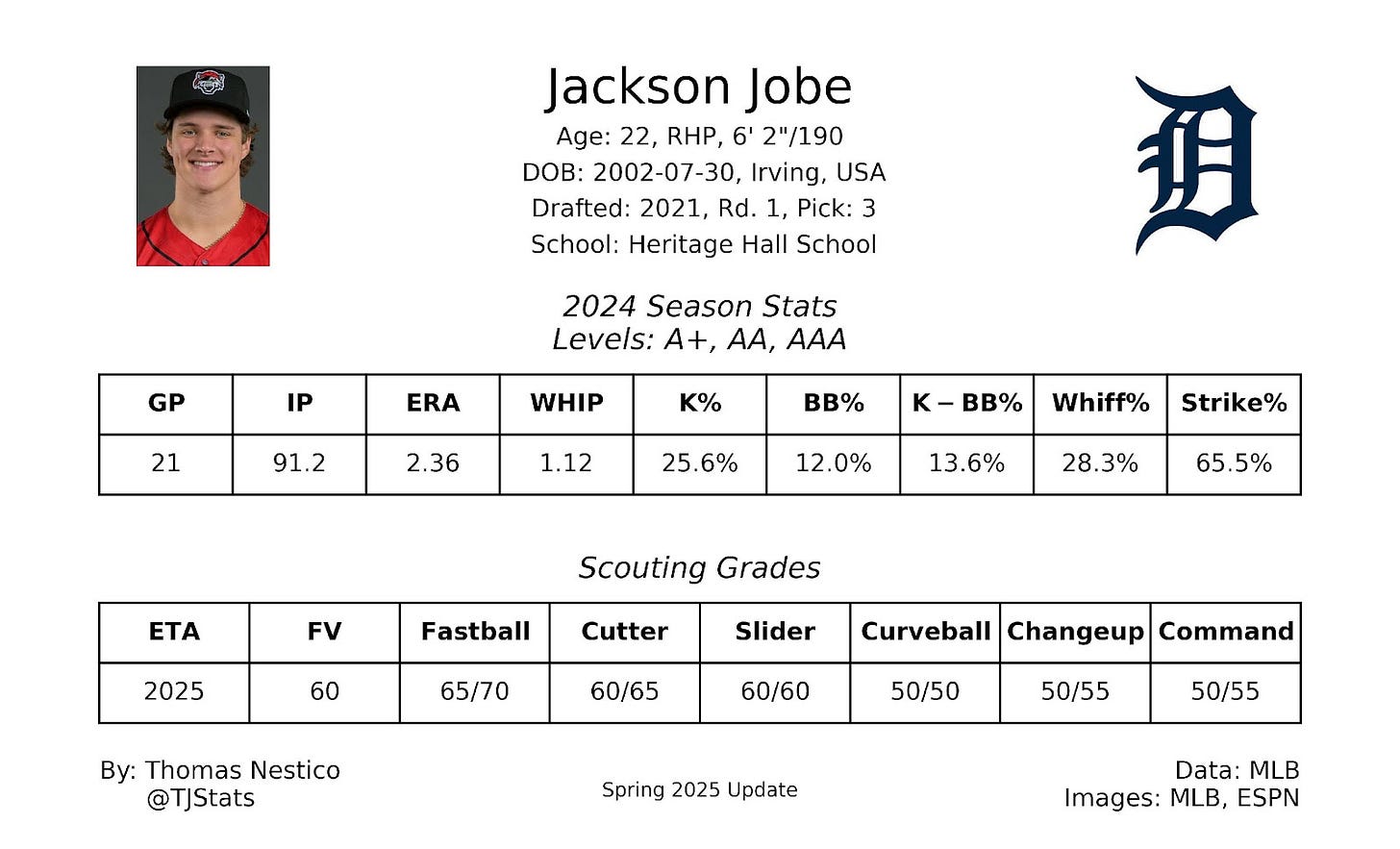

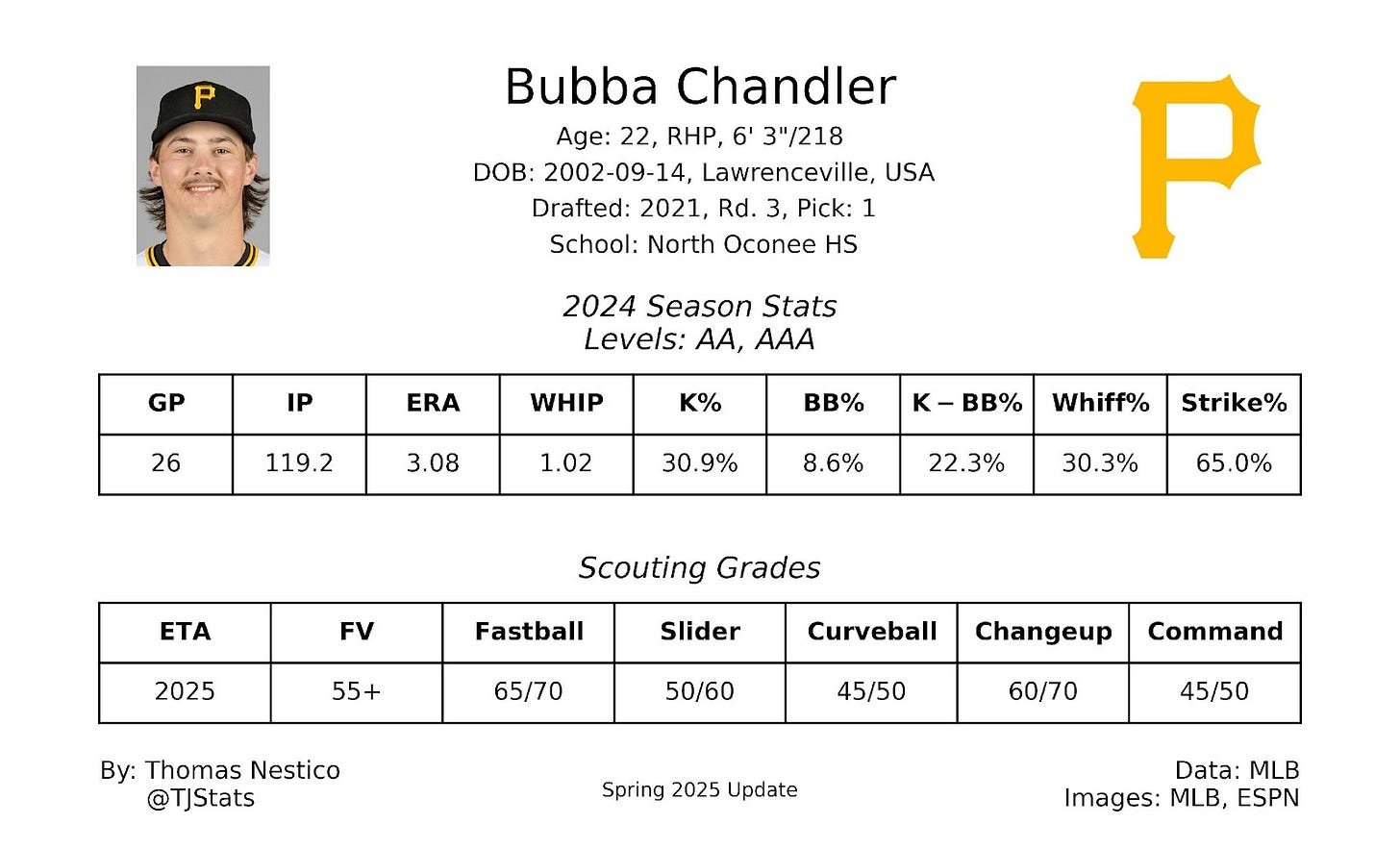

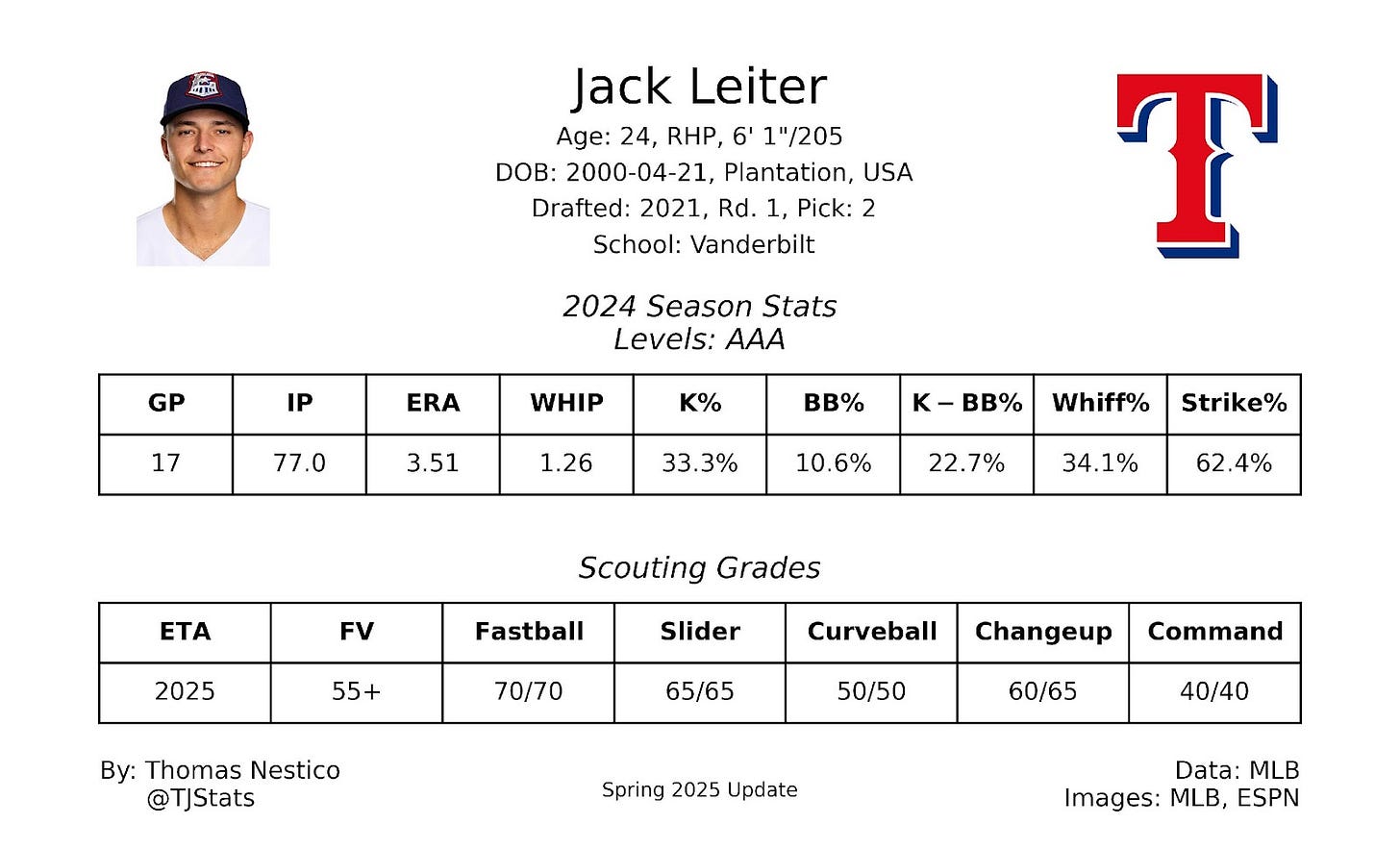

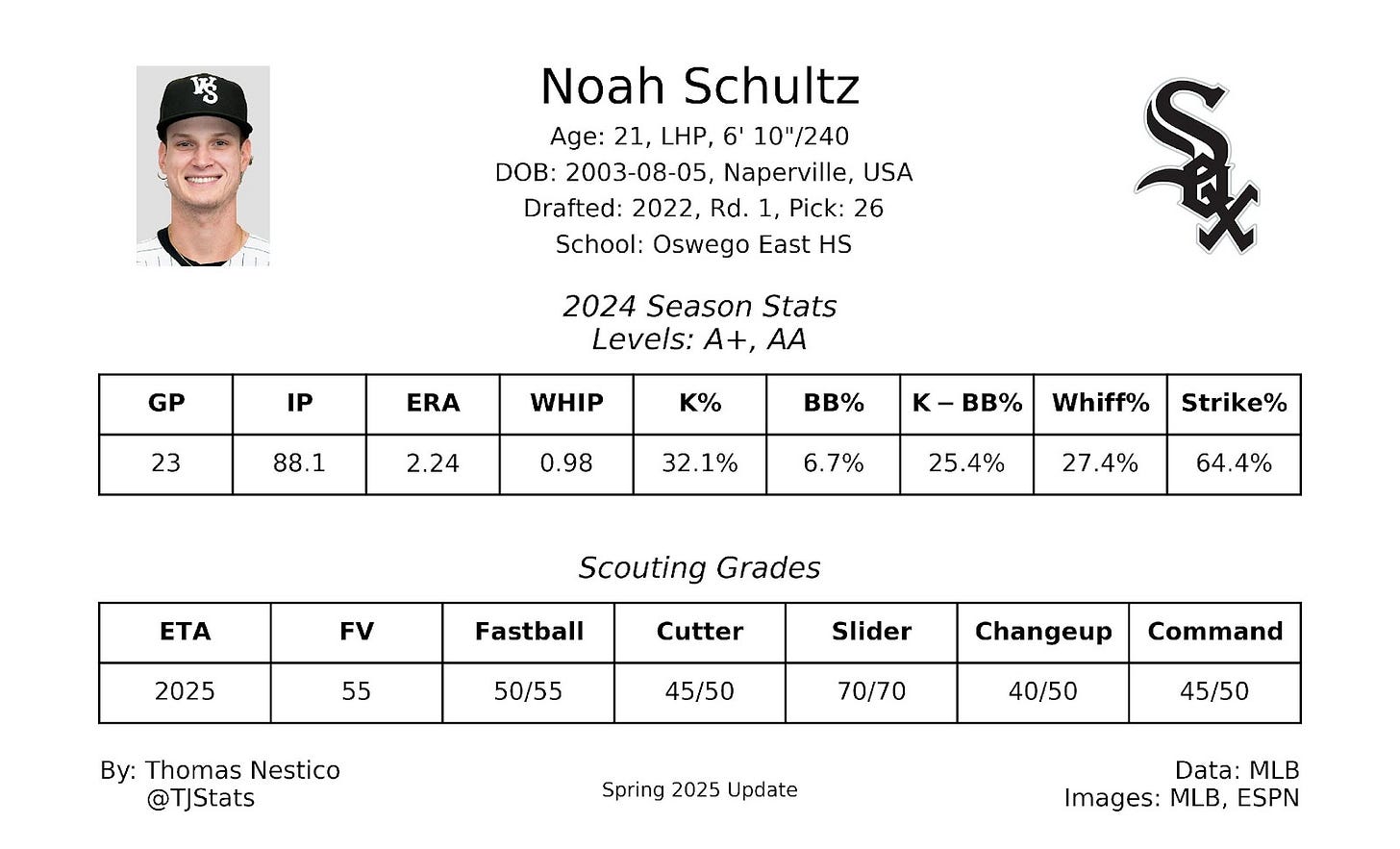
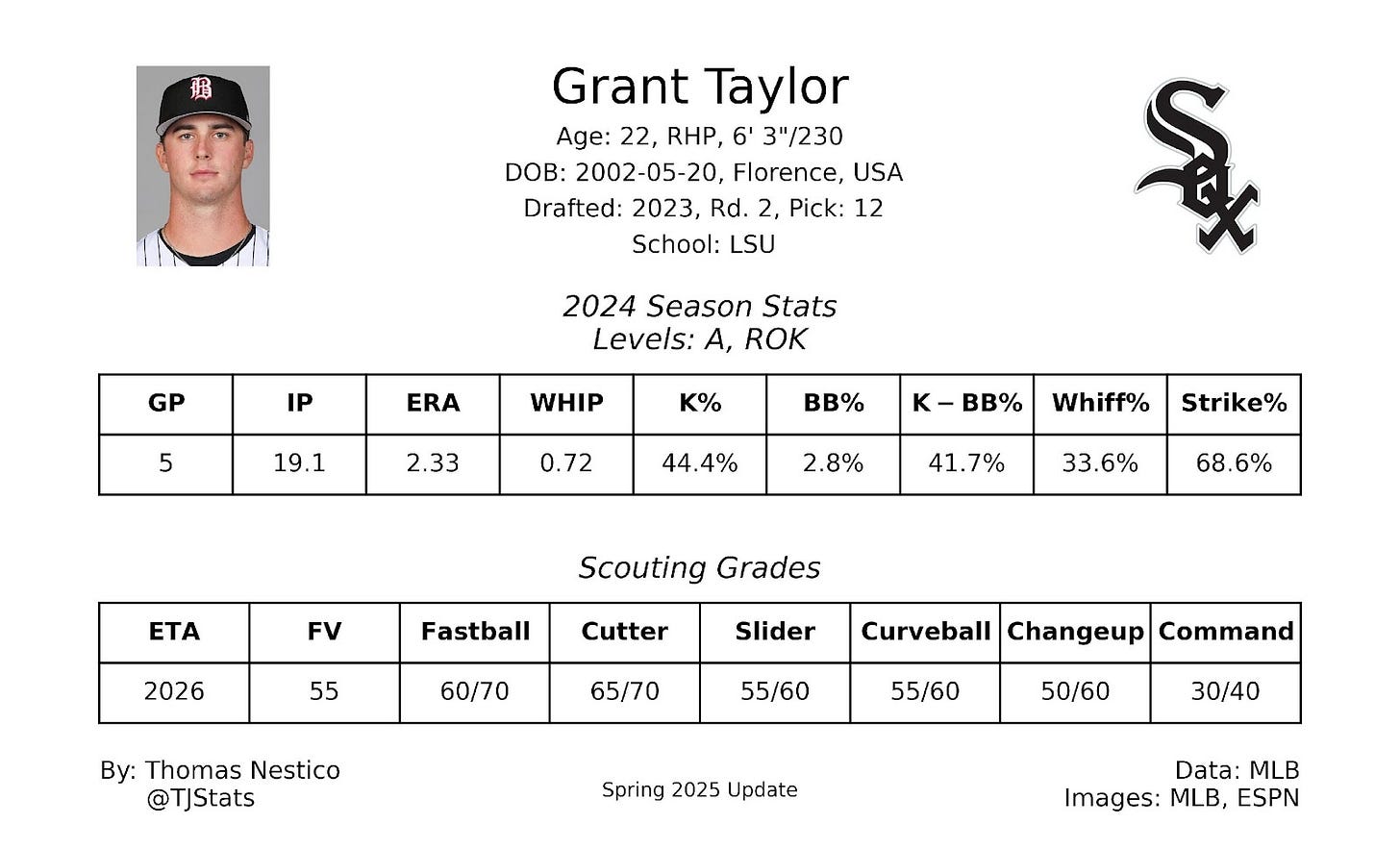
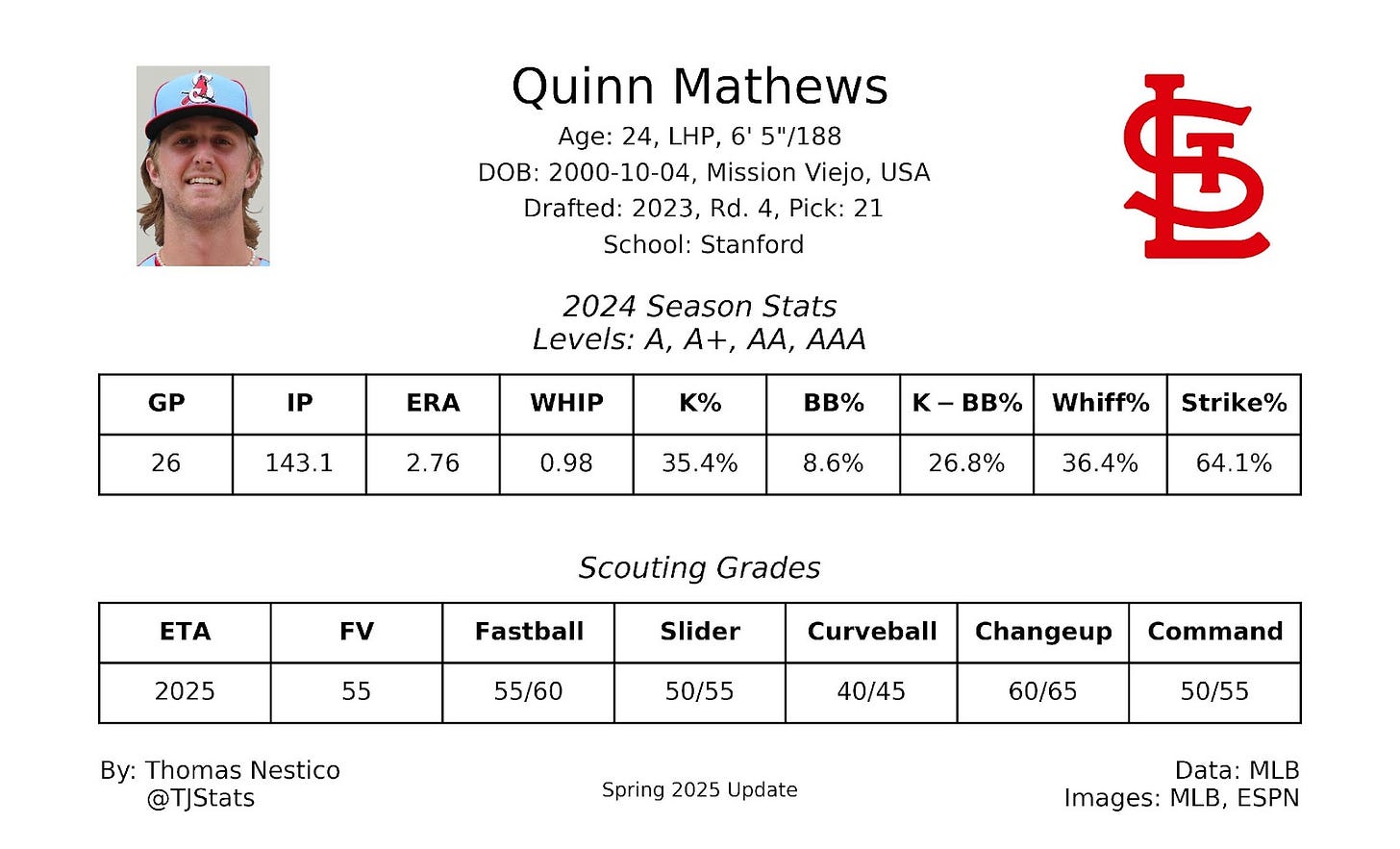

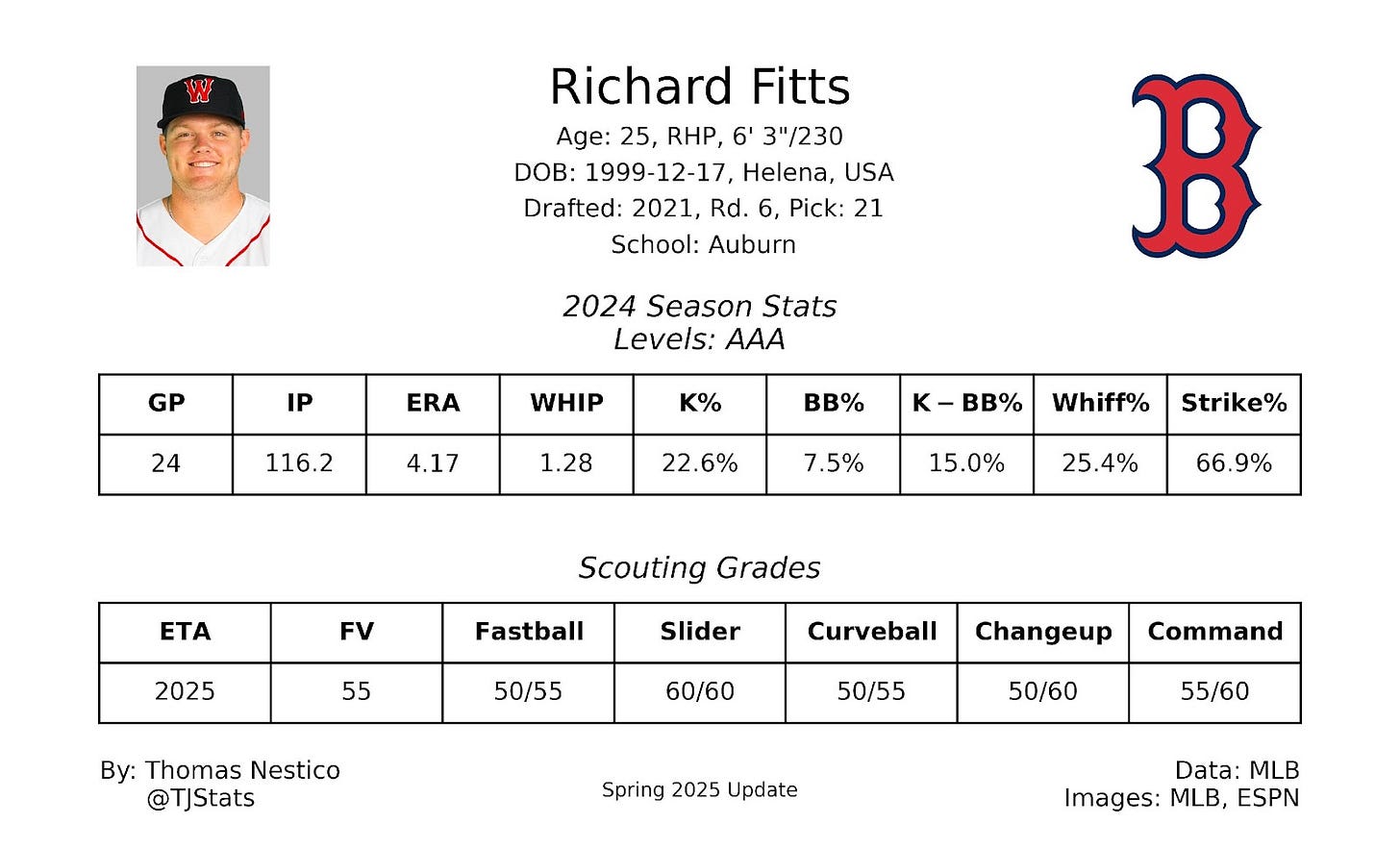
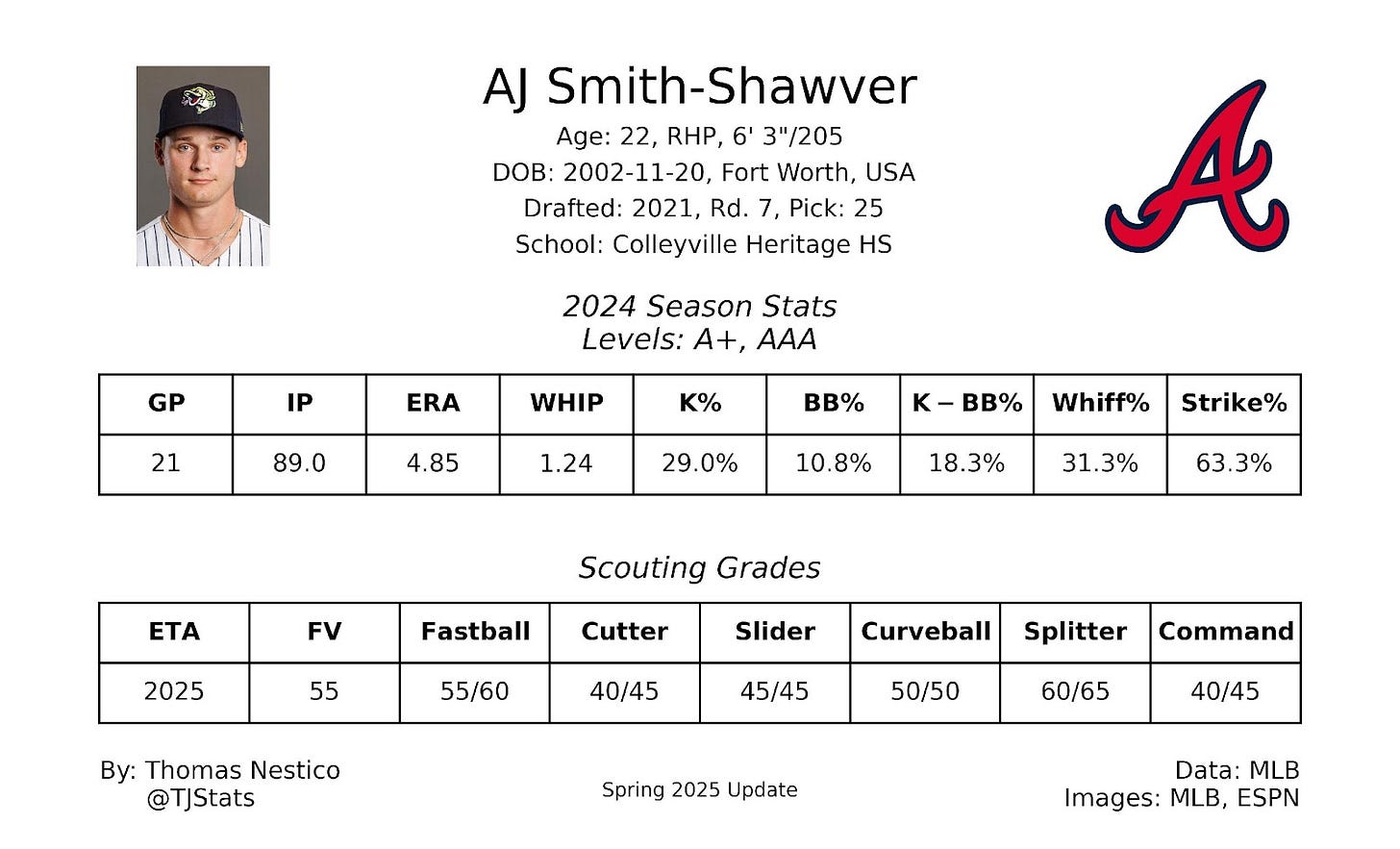
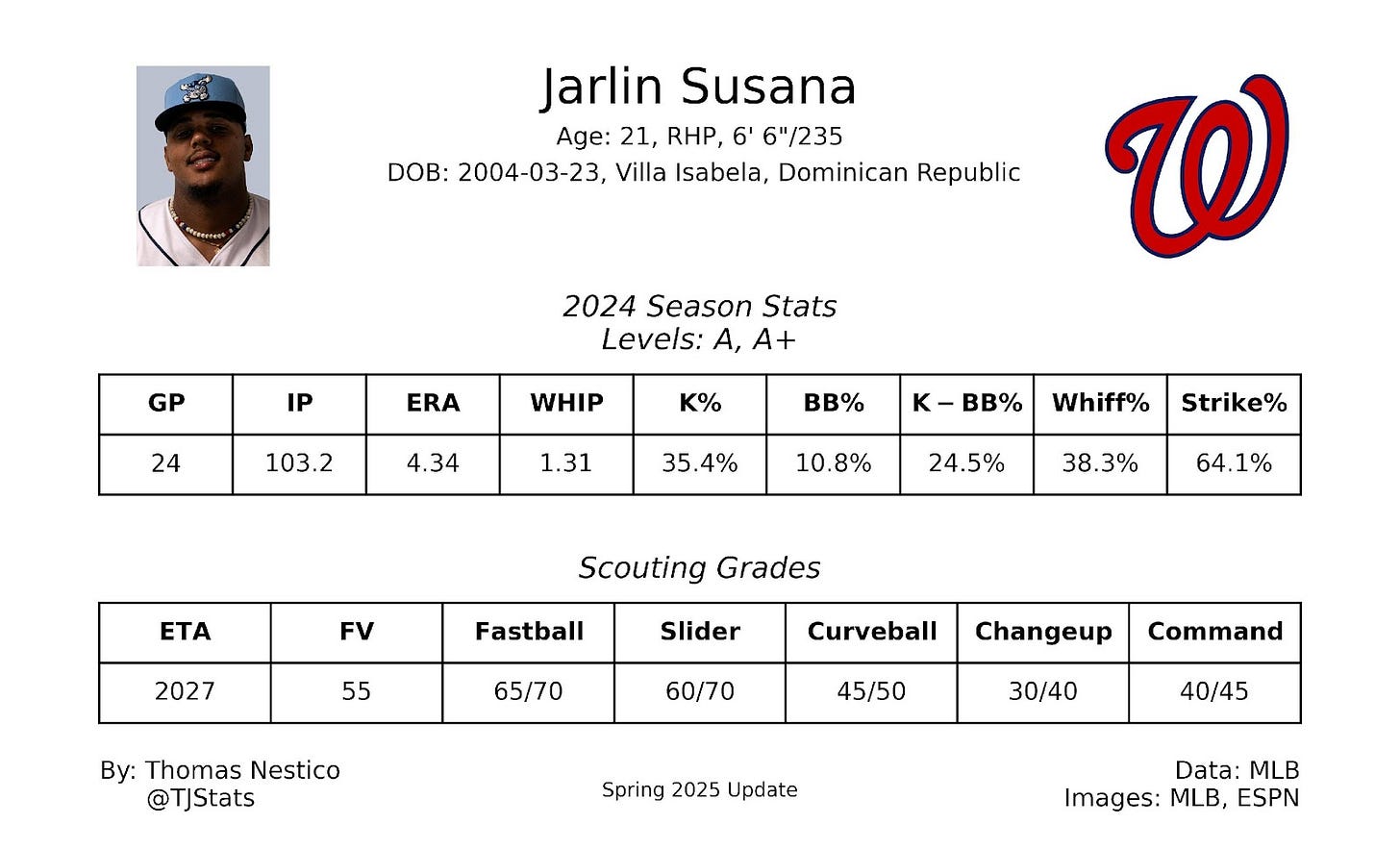
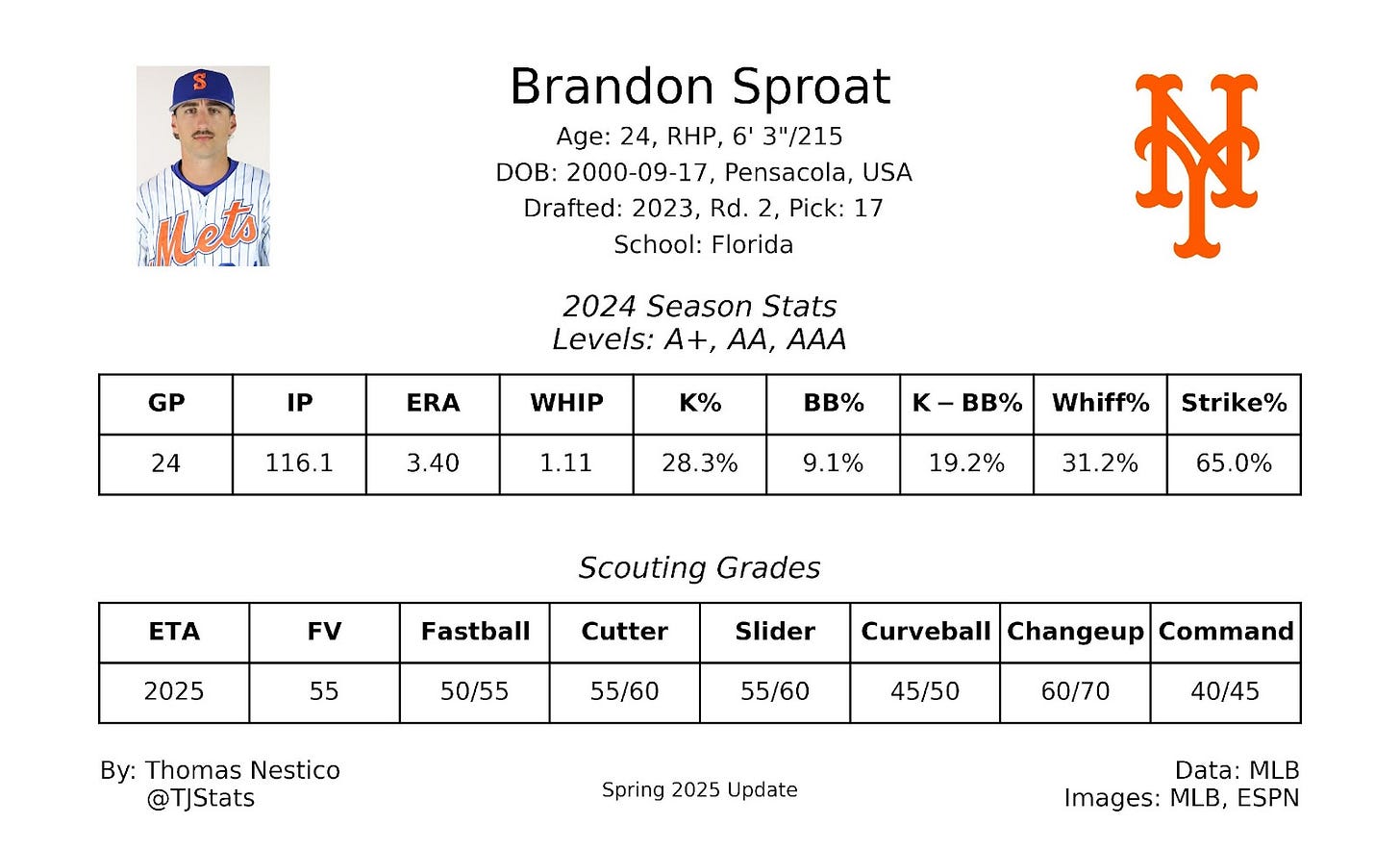

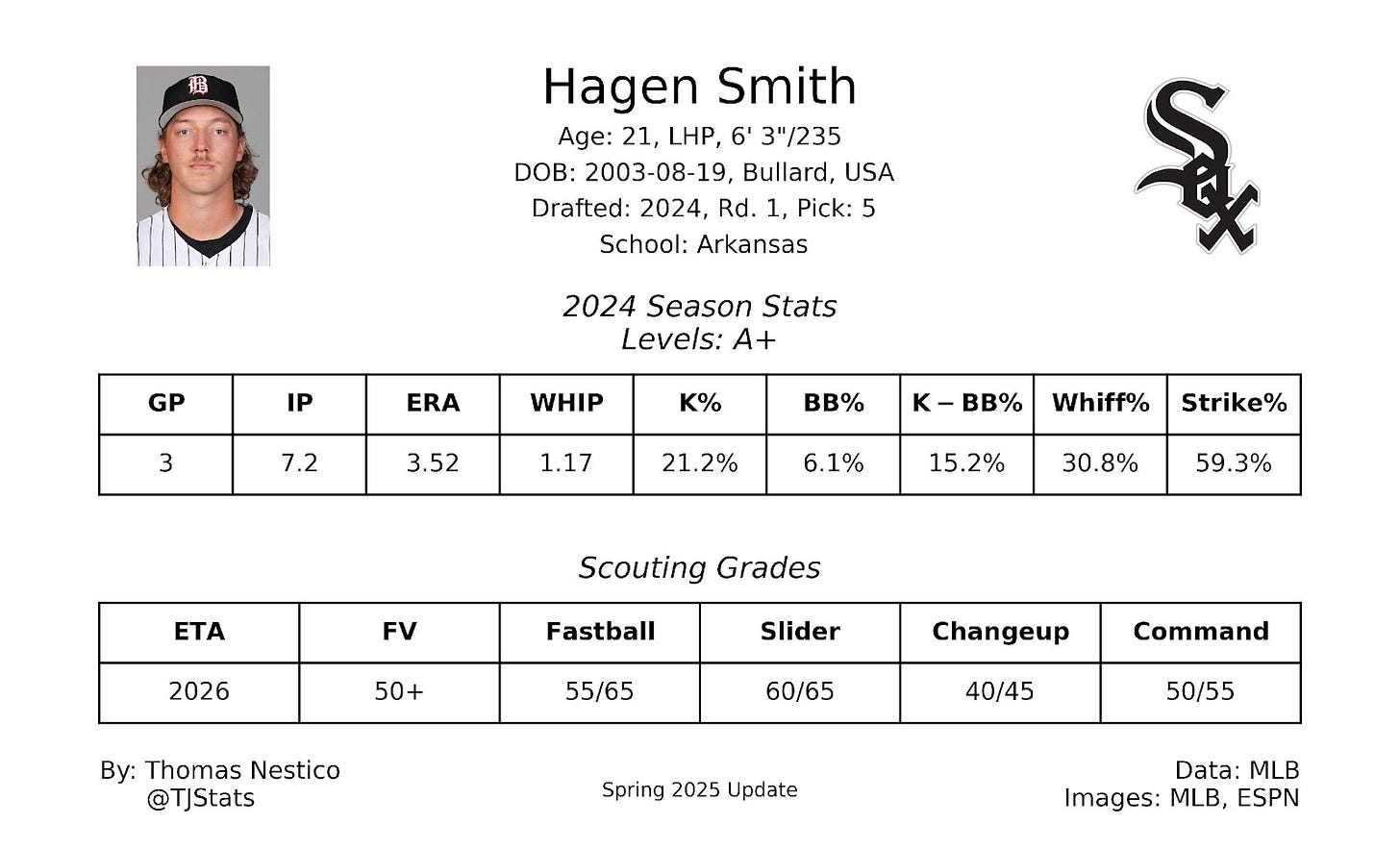





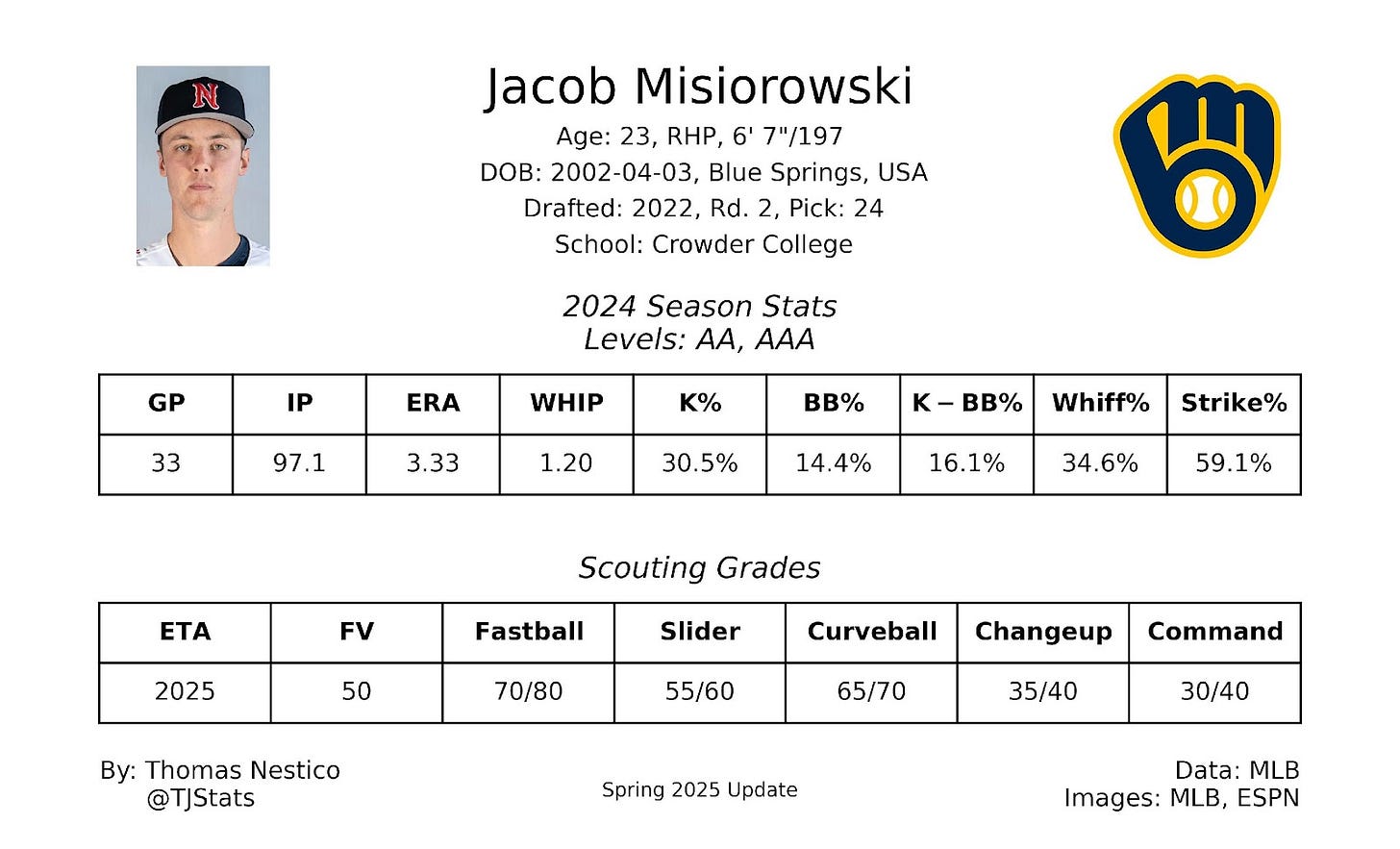
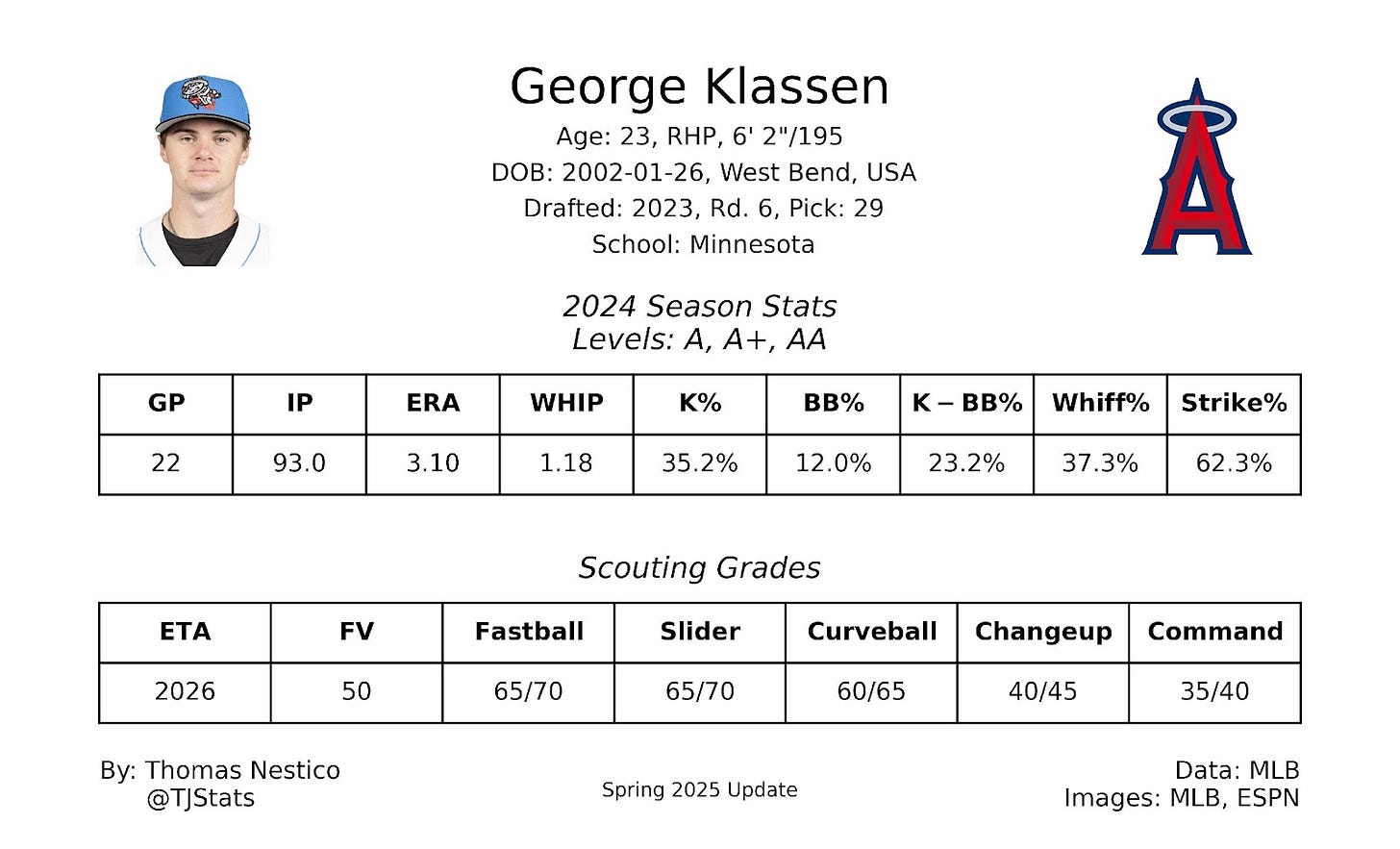
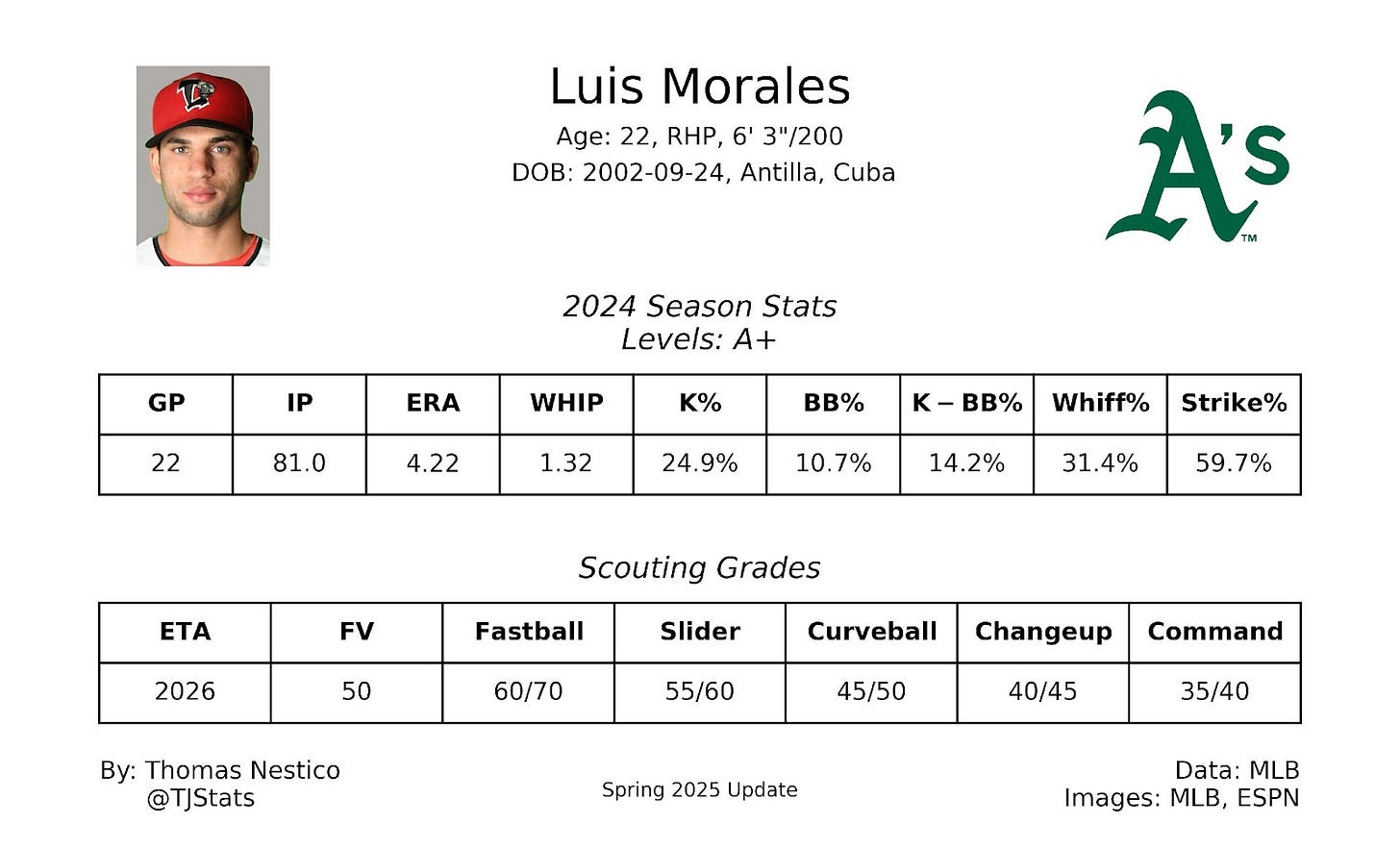
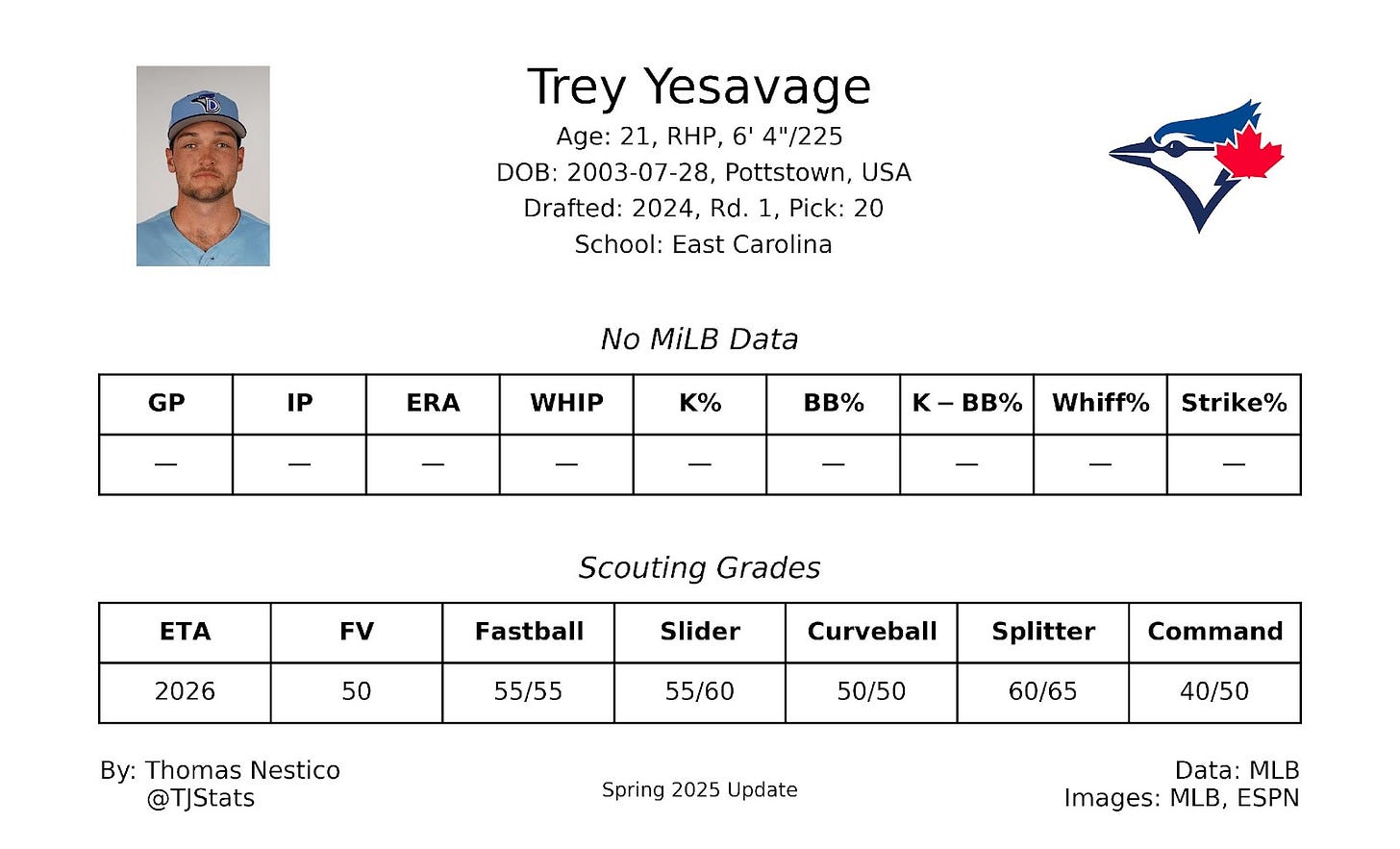
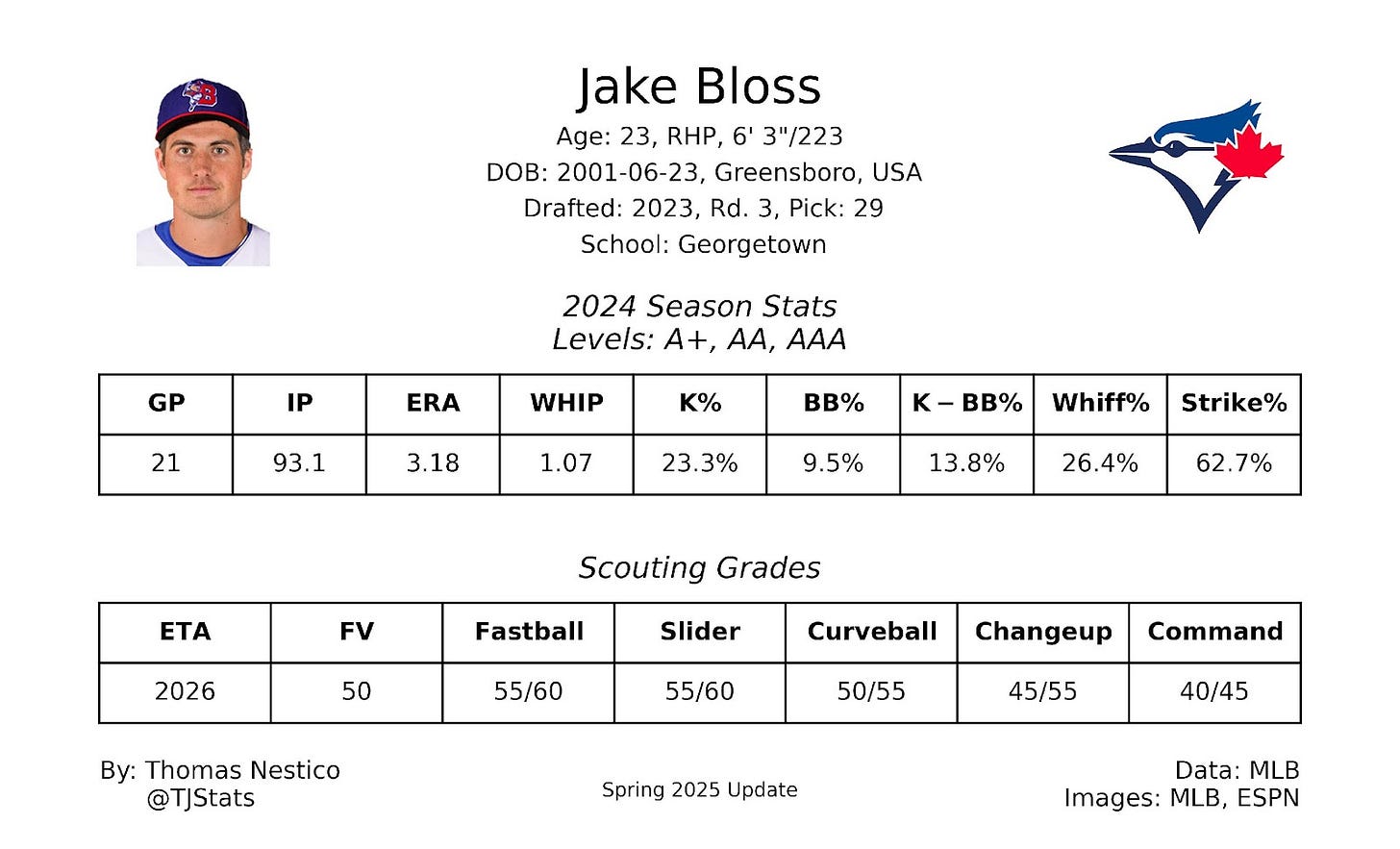
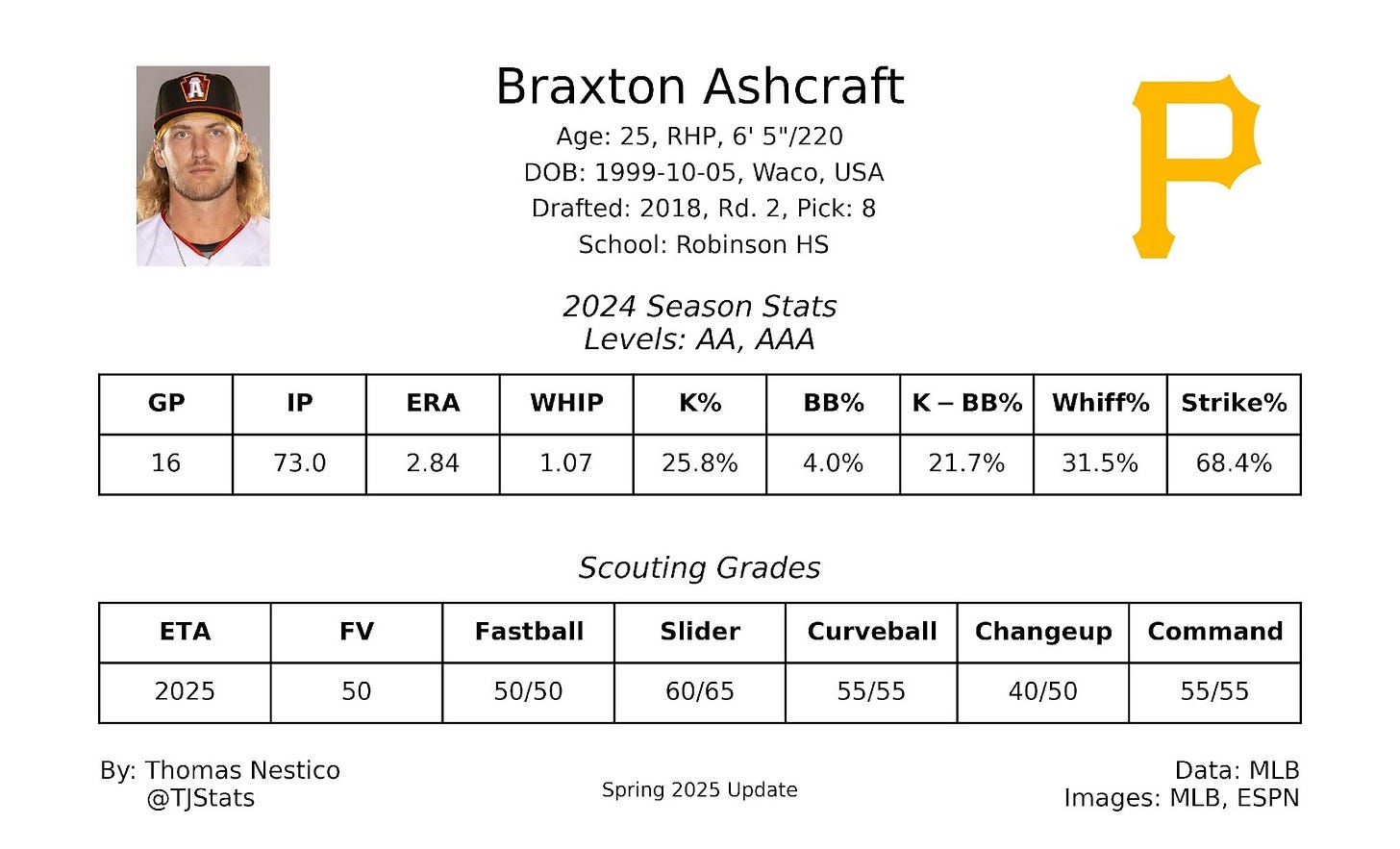

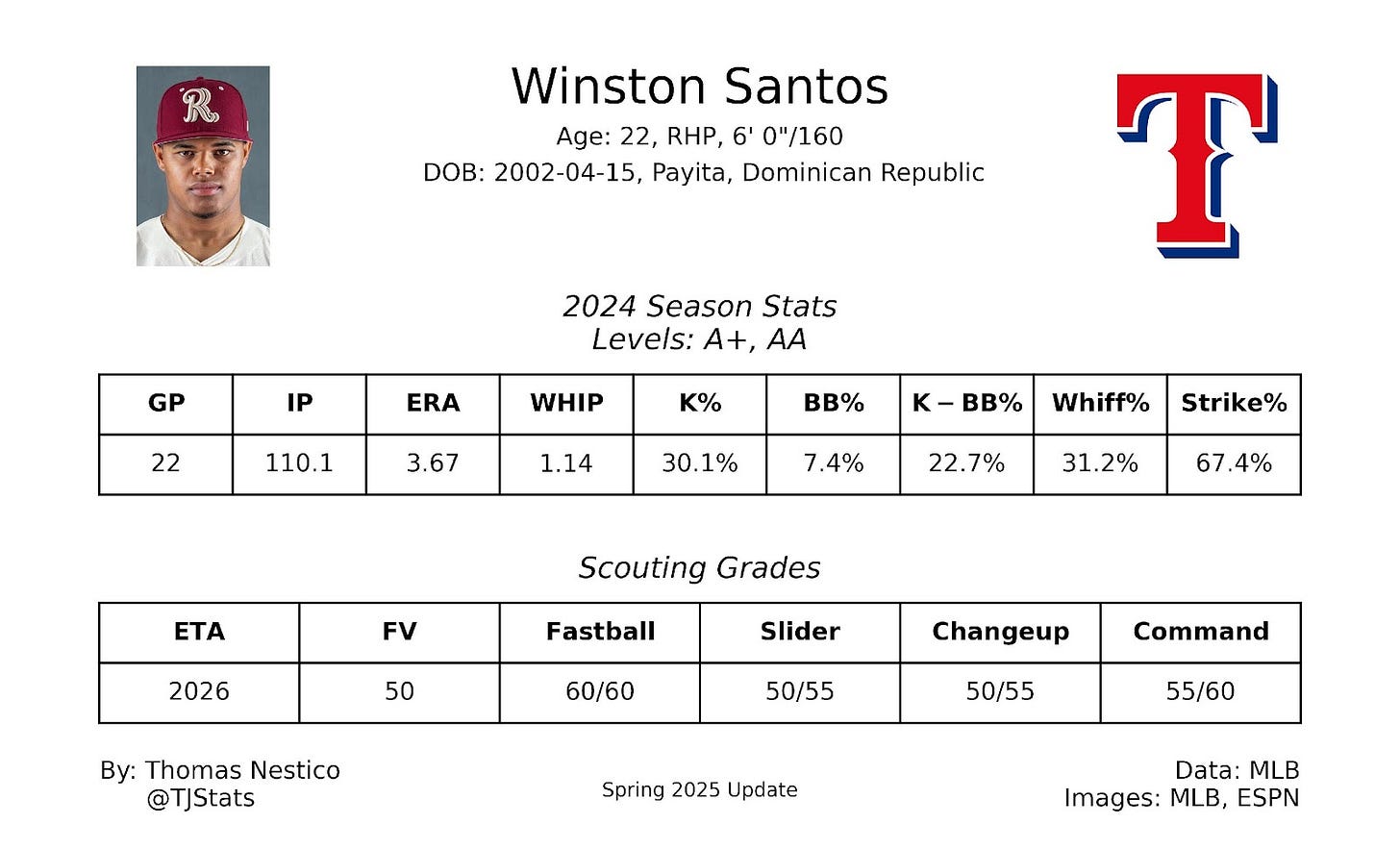




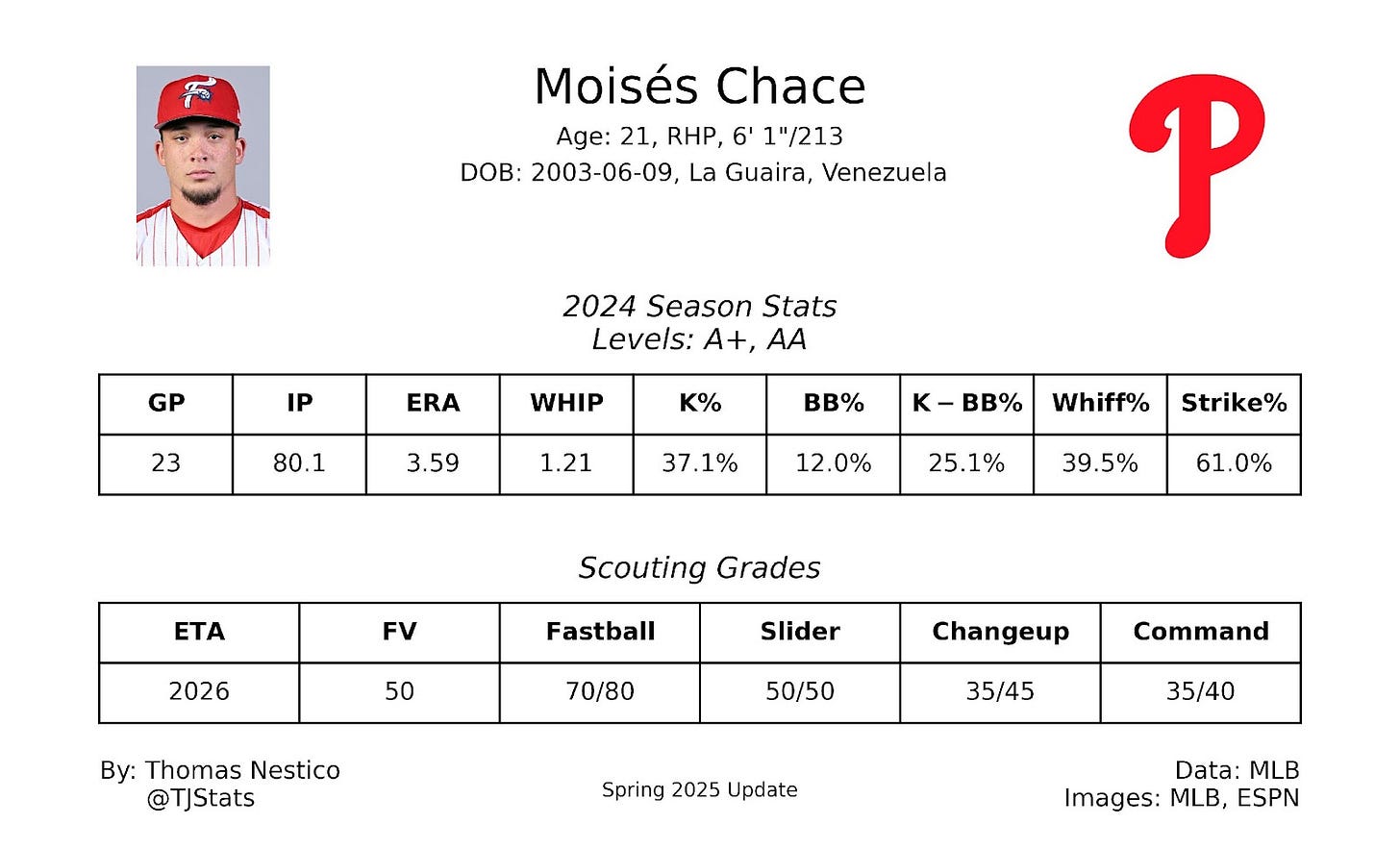
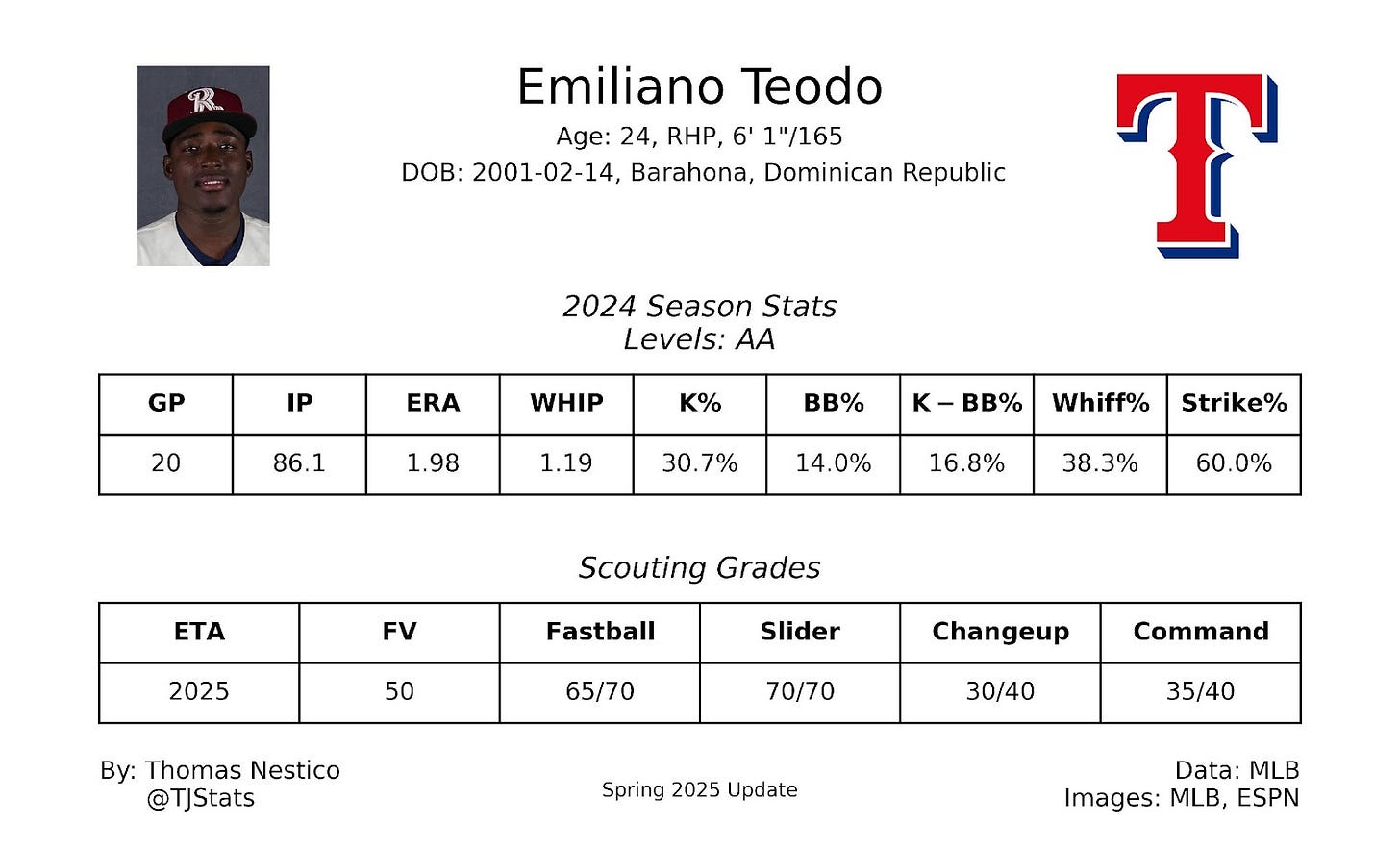
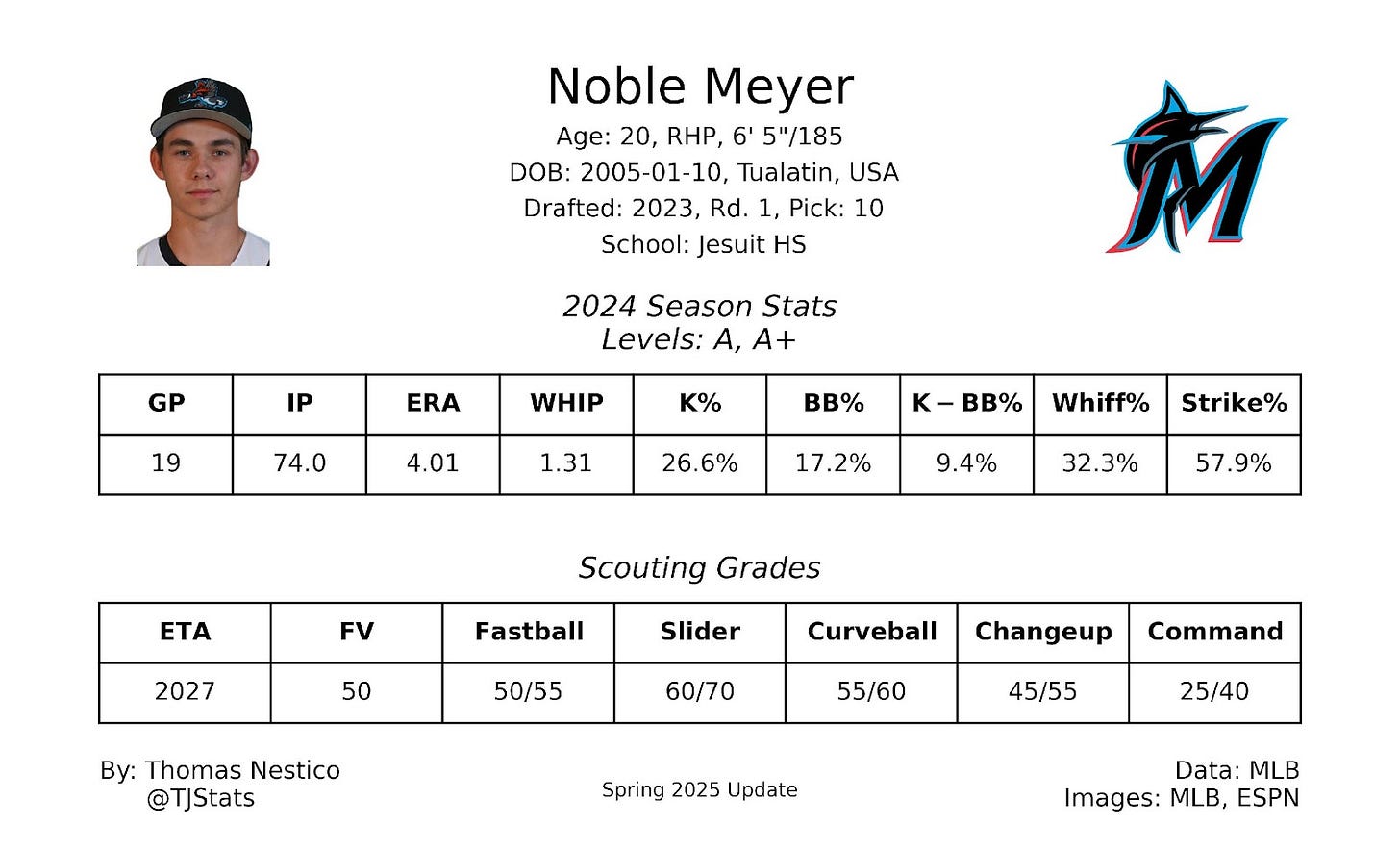



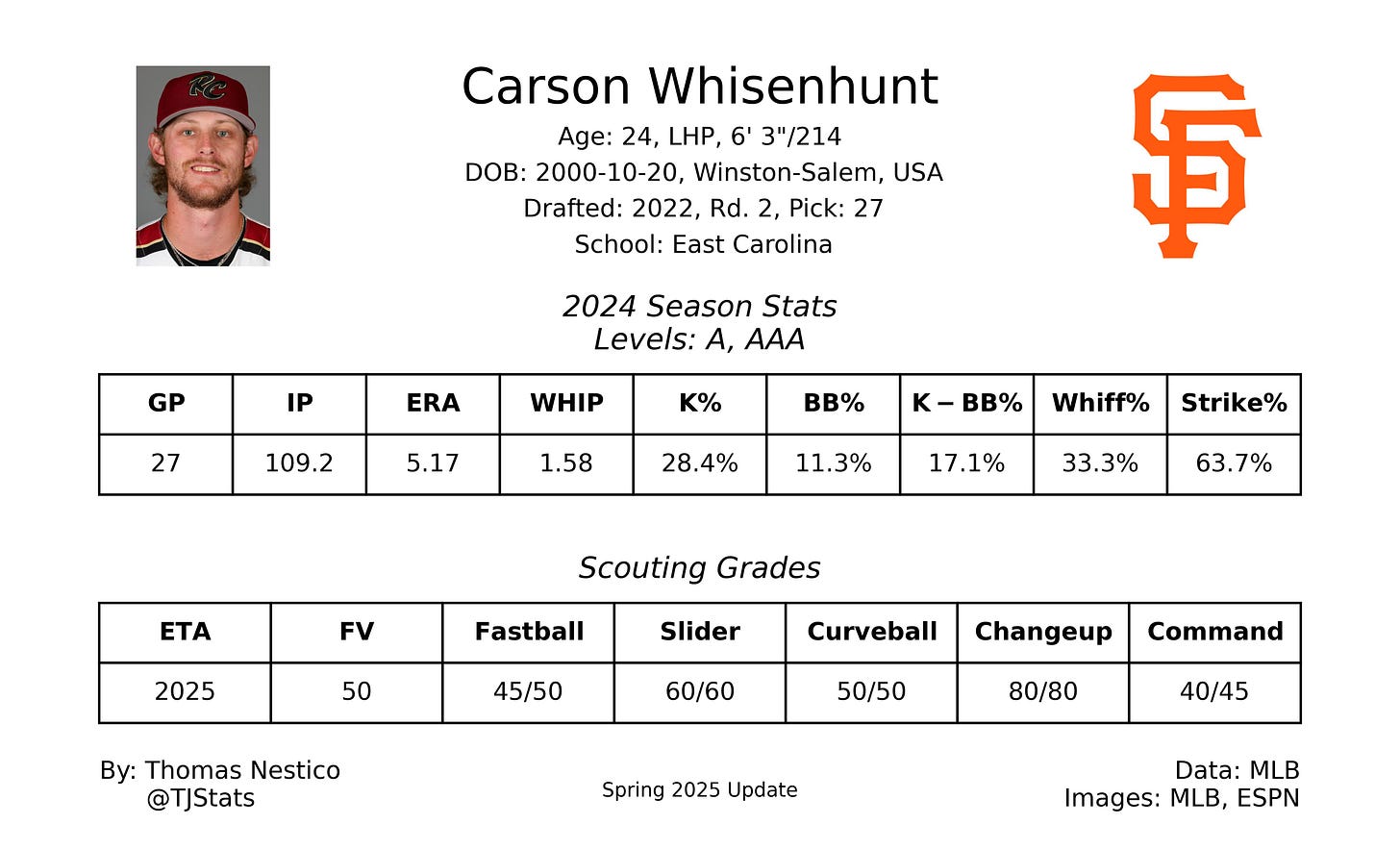





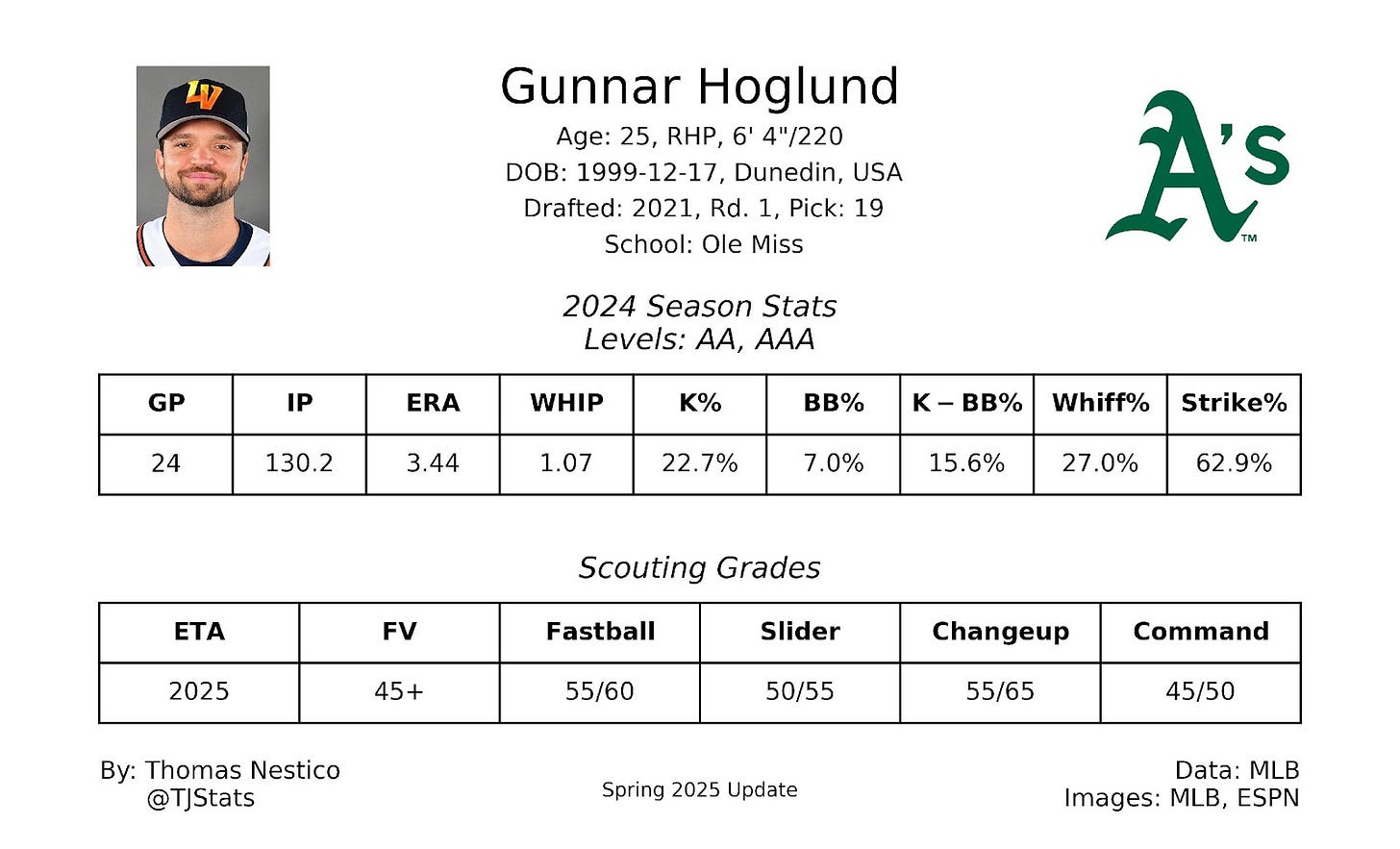









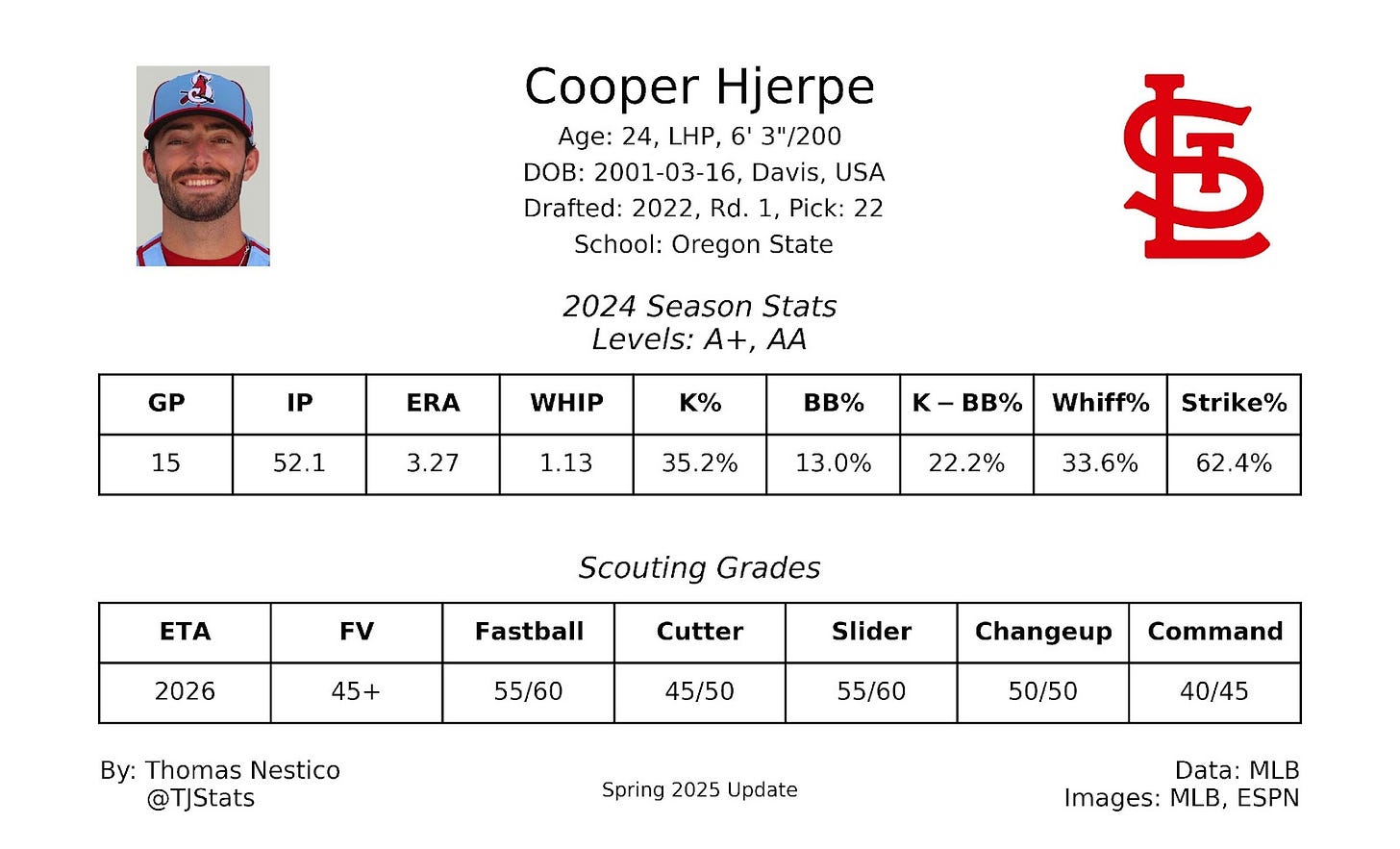


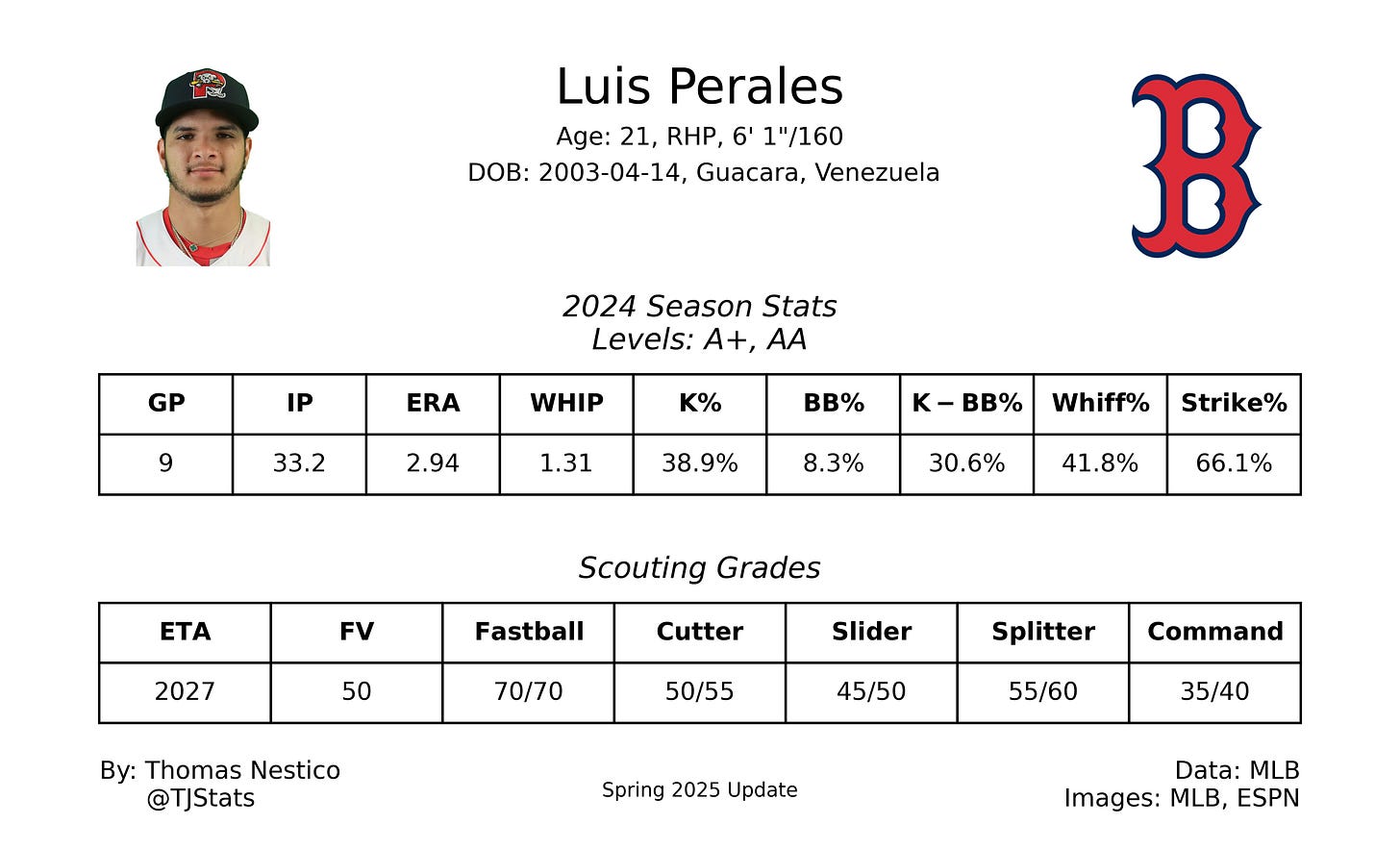


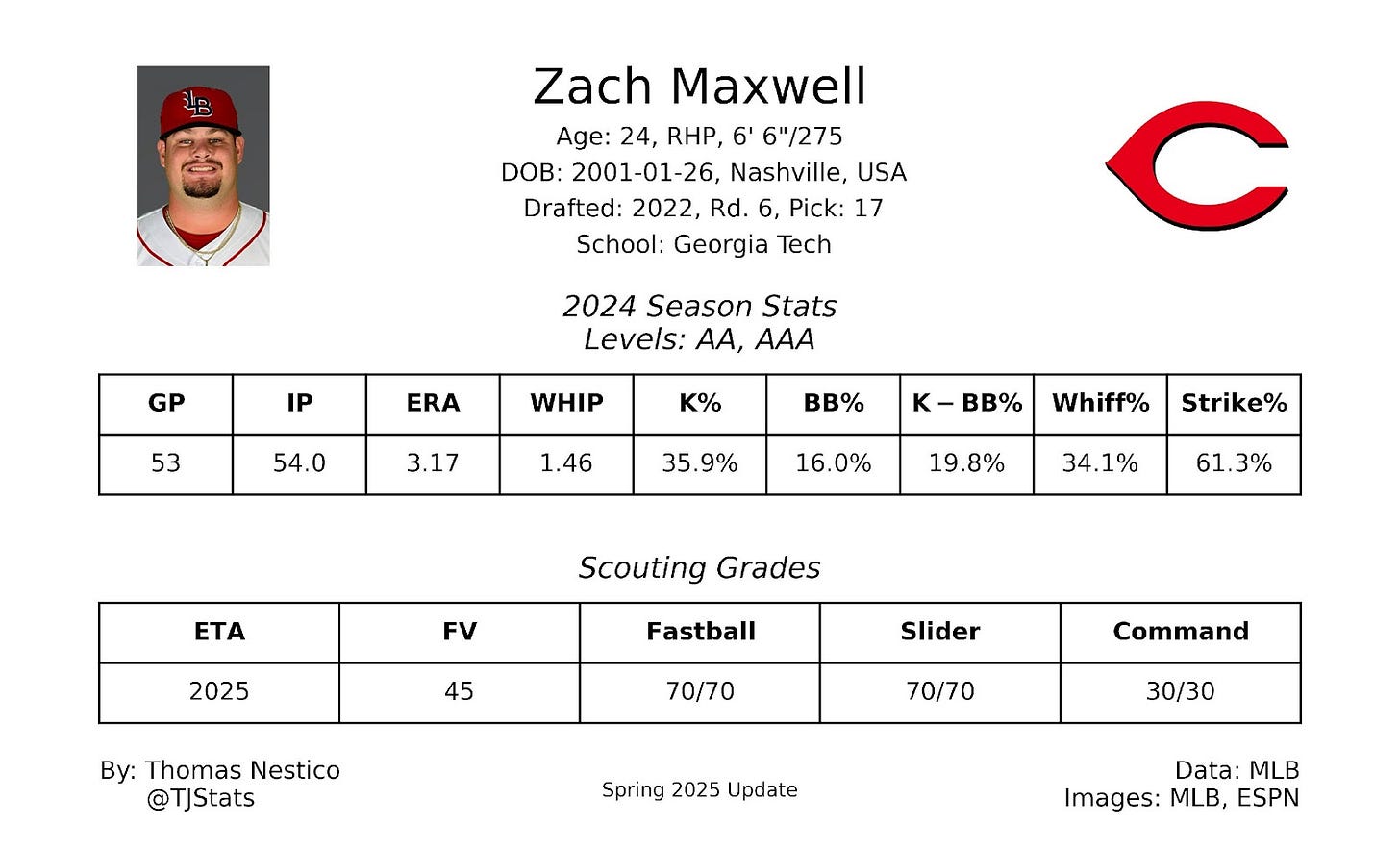

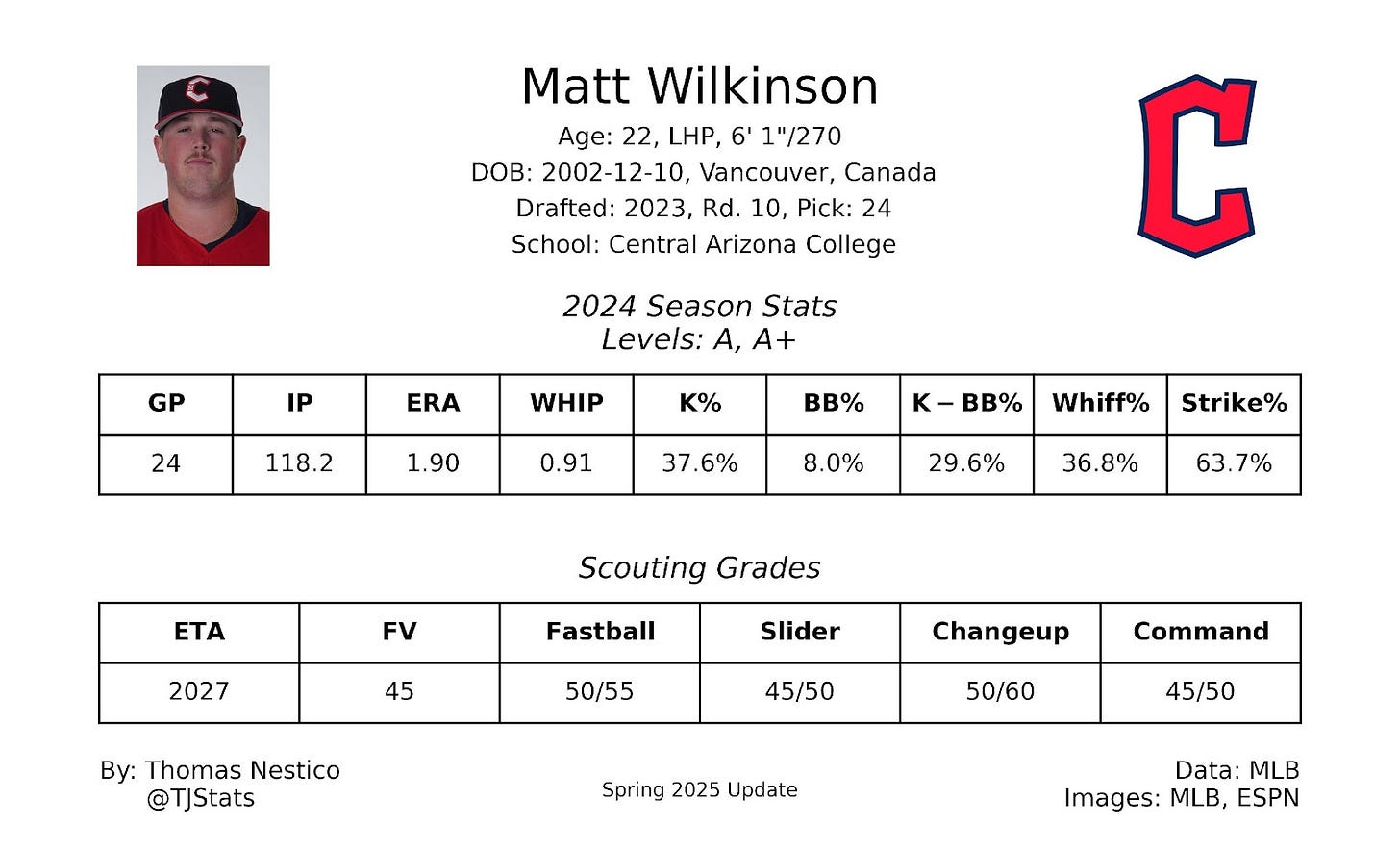


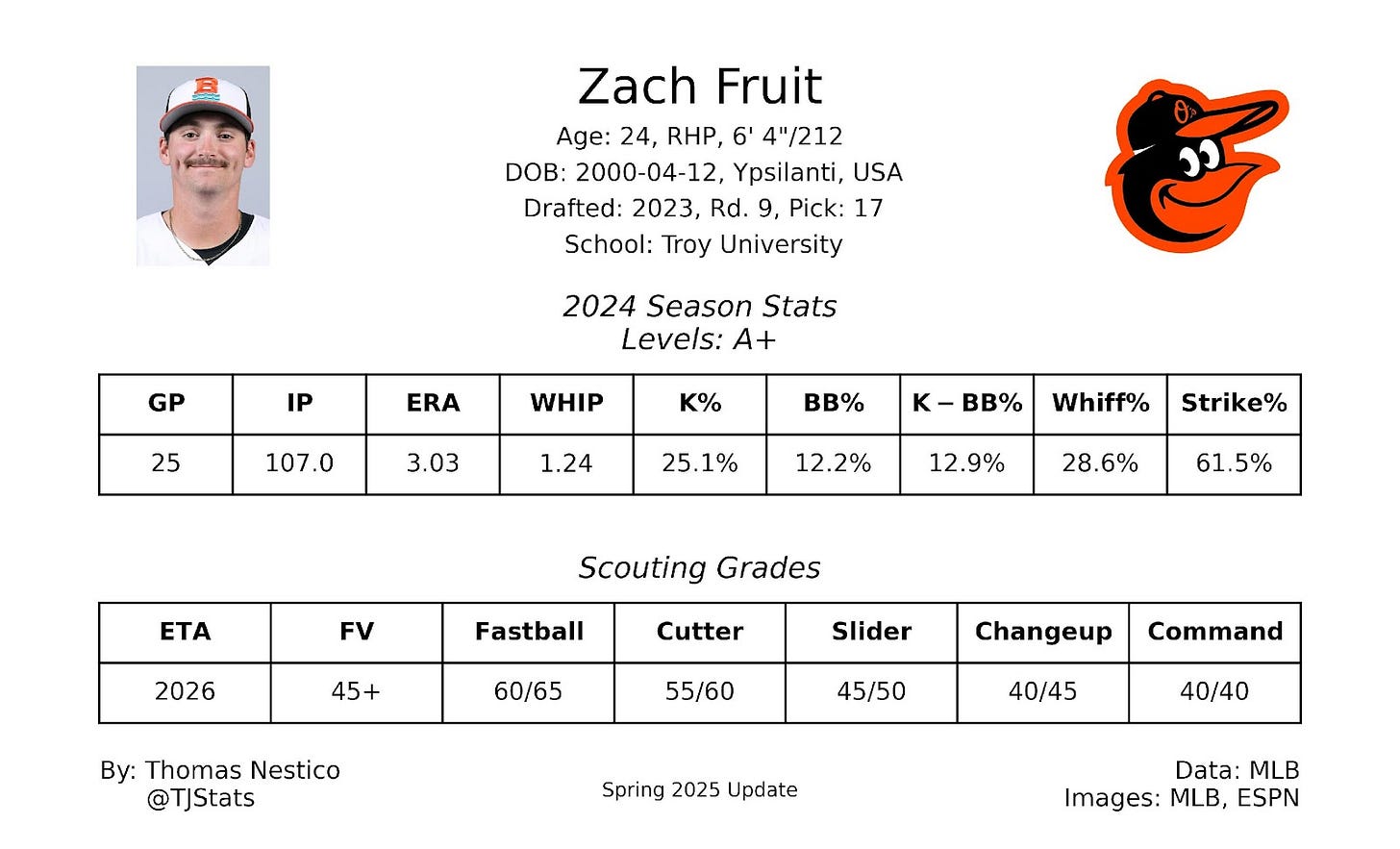





nice job
What kept Kash Mayfeild off this list? I would to hear your thoughts on the Padres prospect pitching depth. Thanks great article.